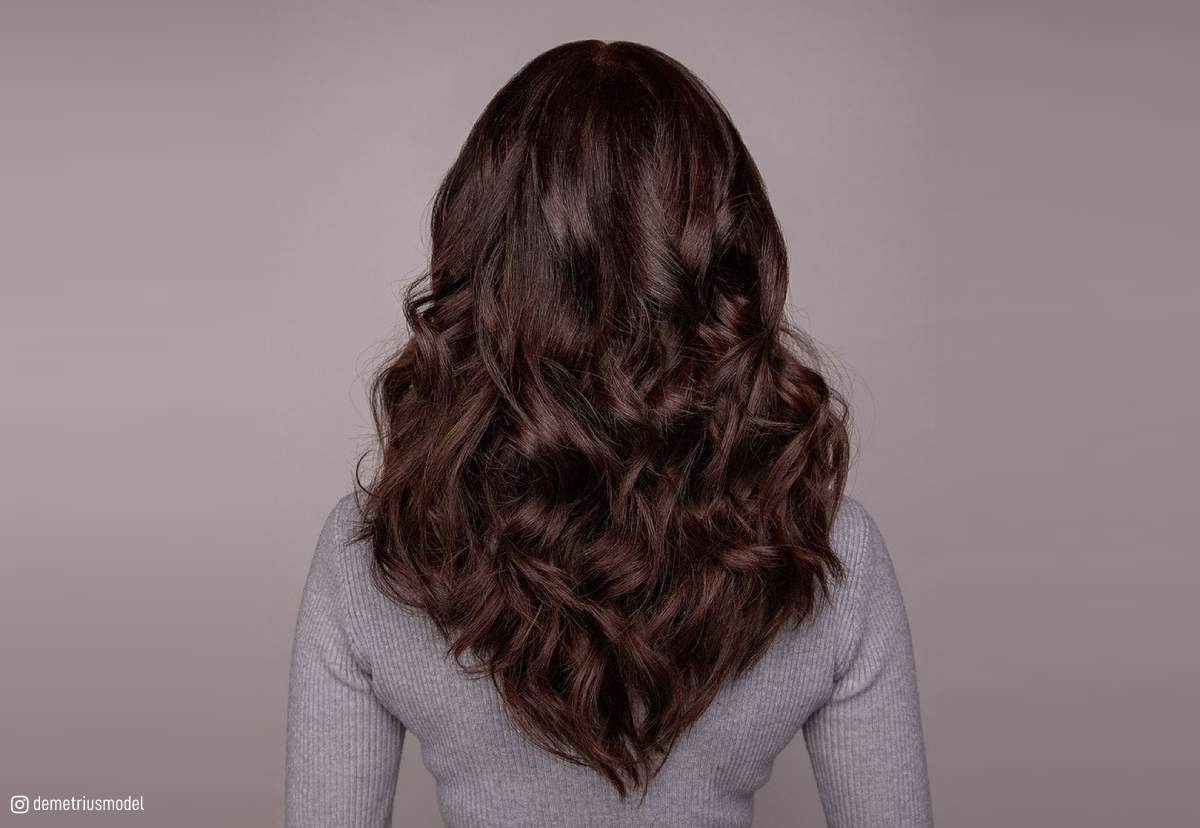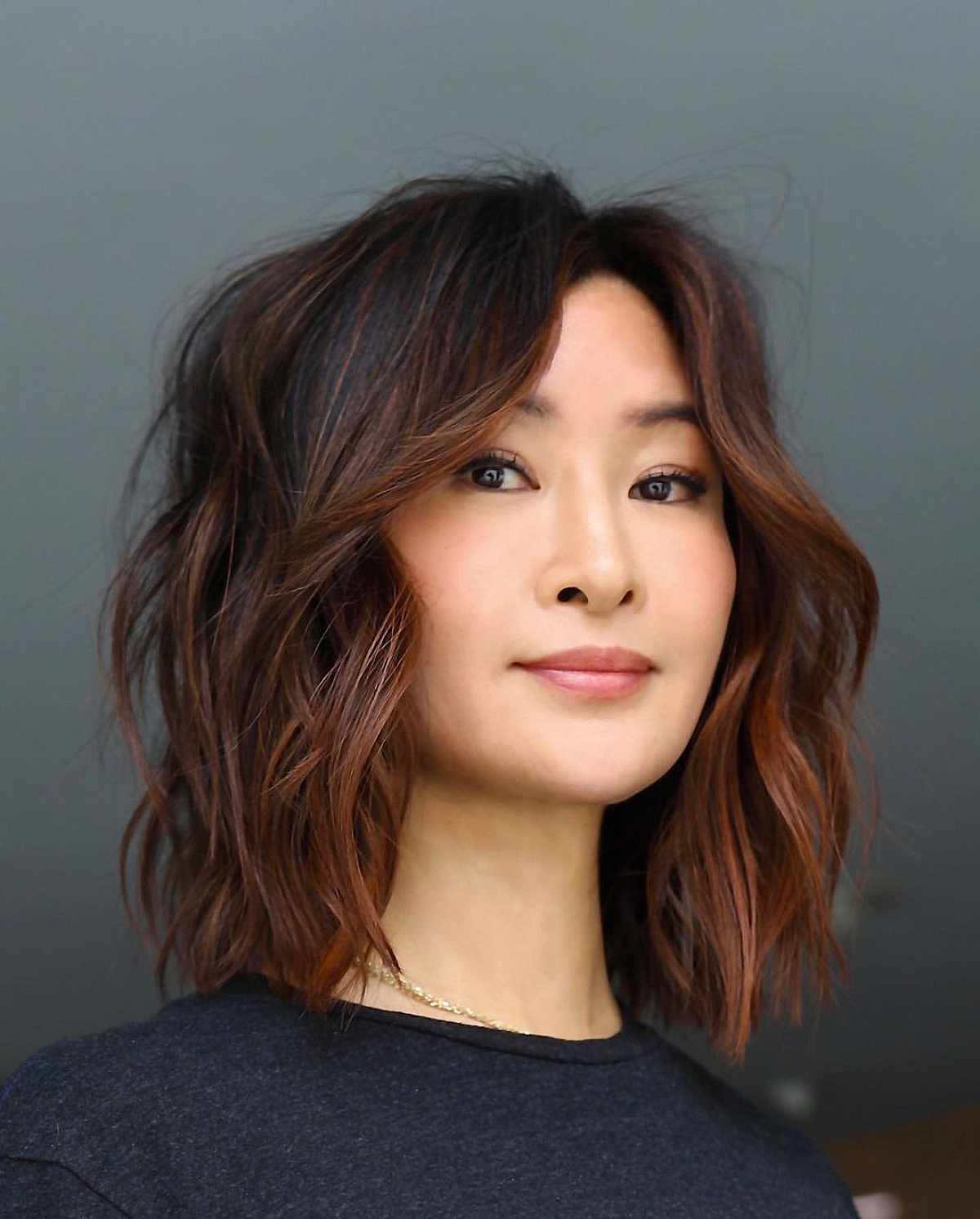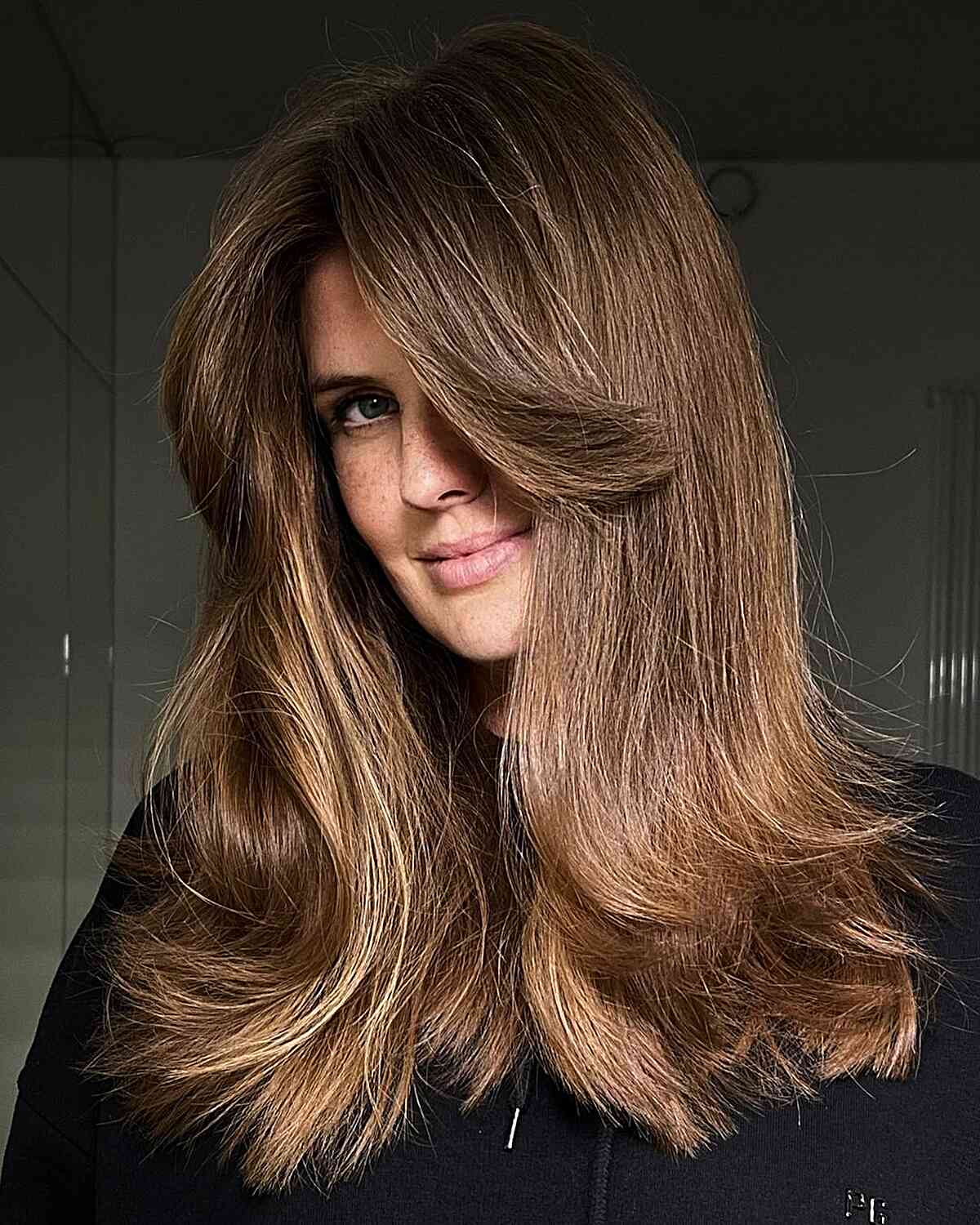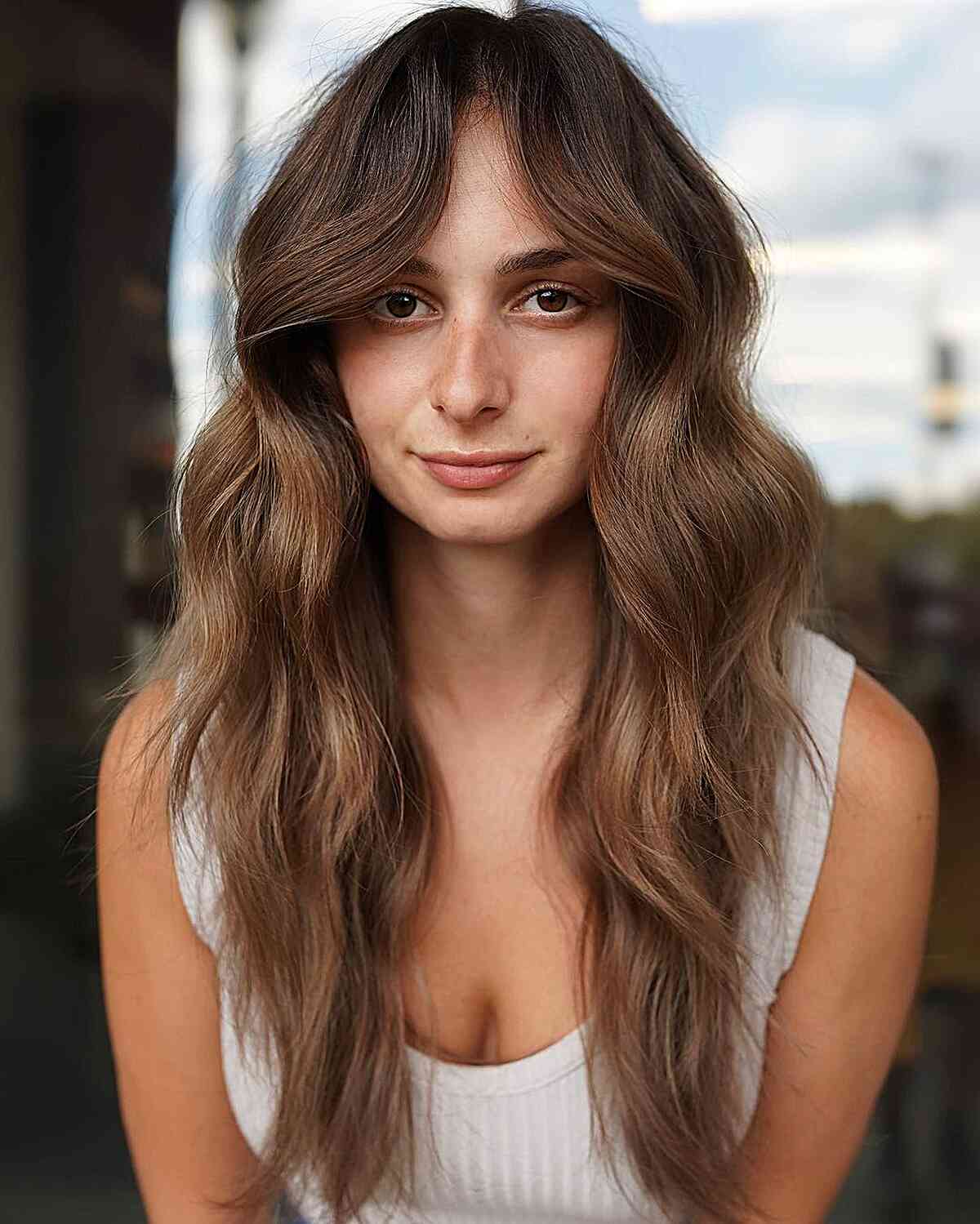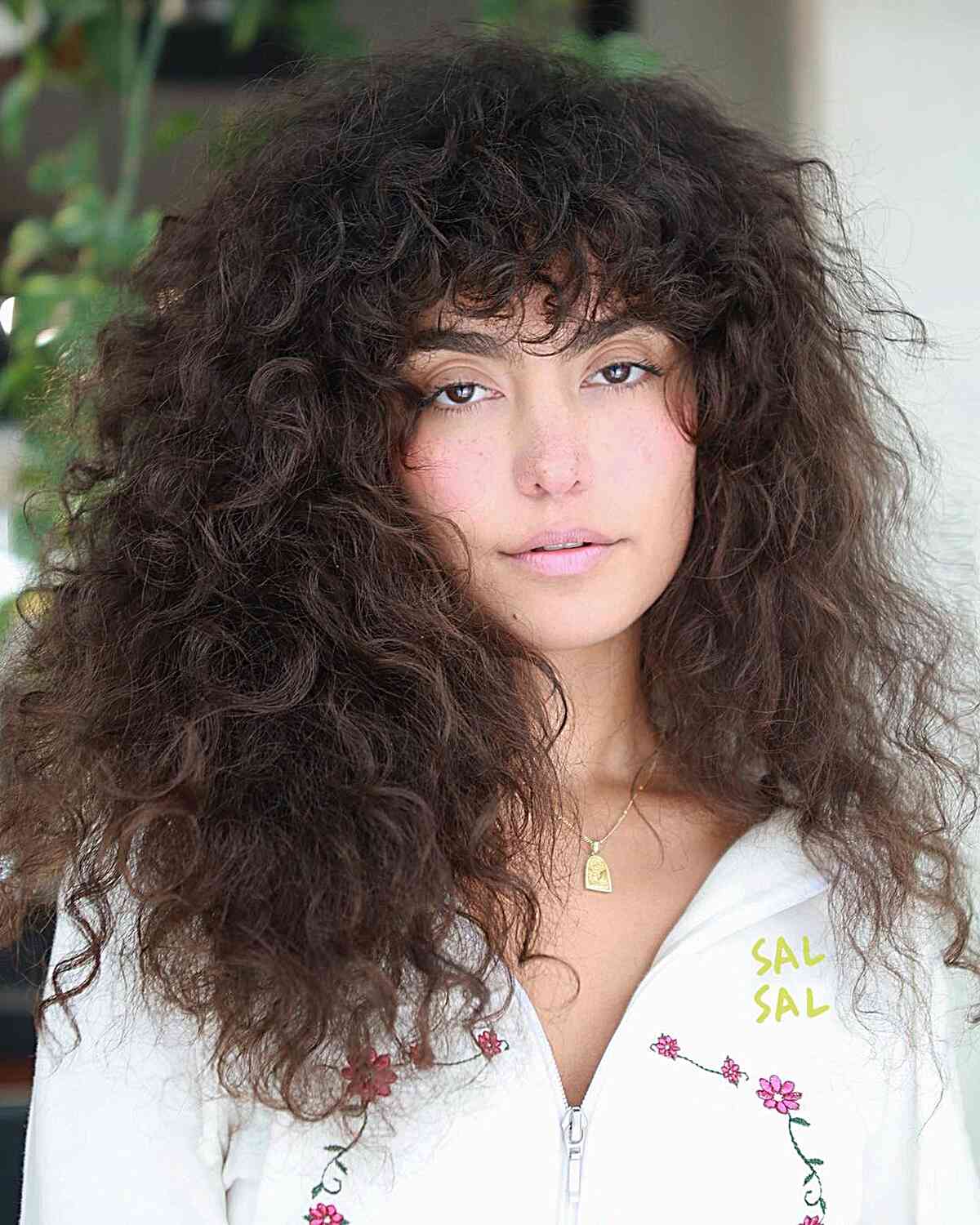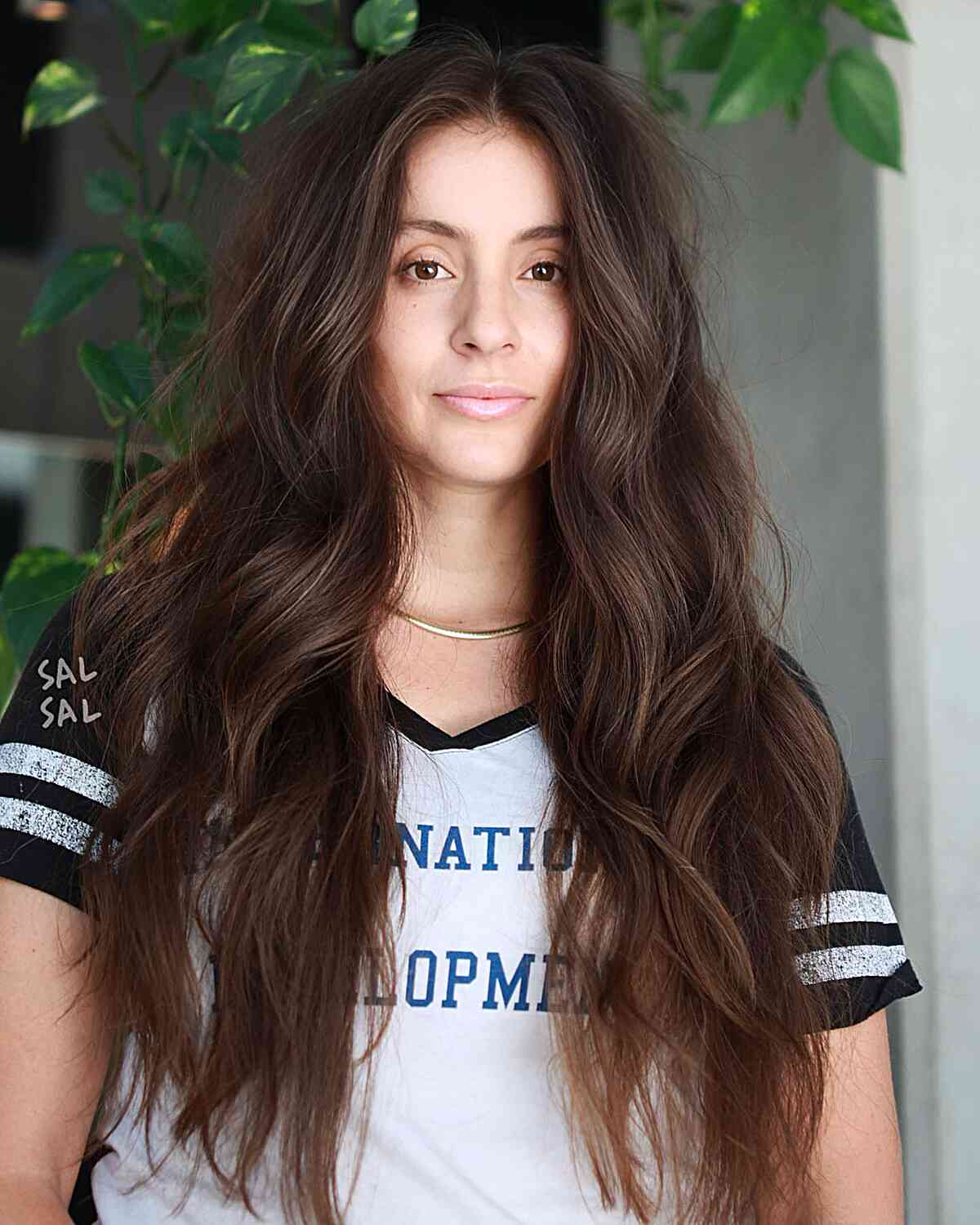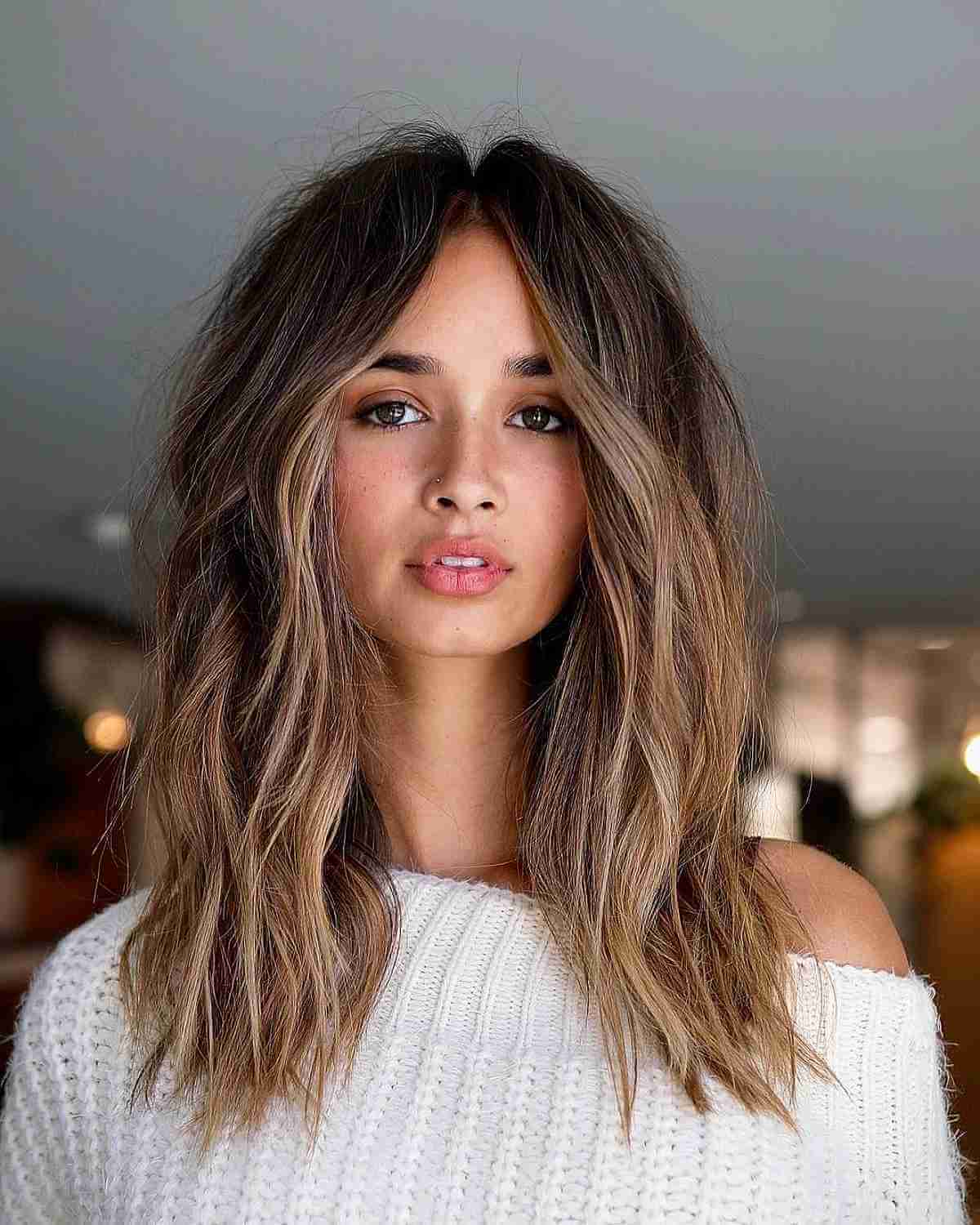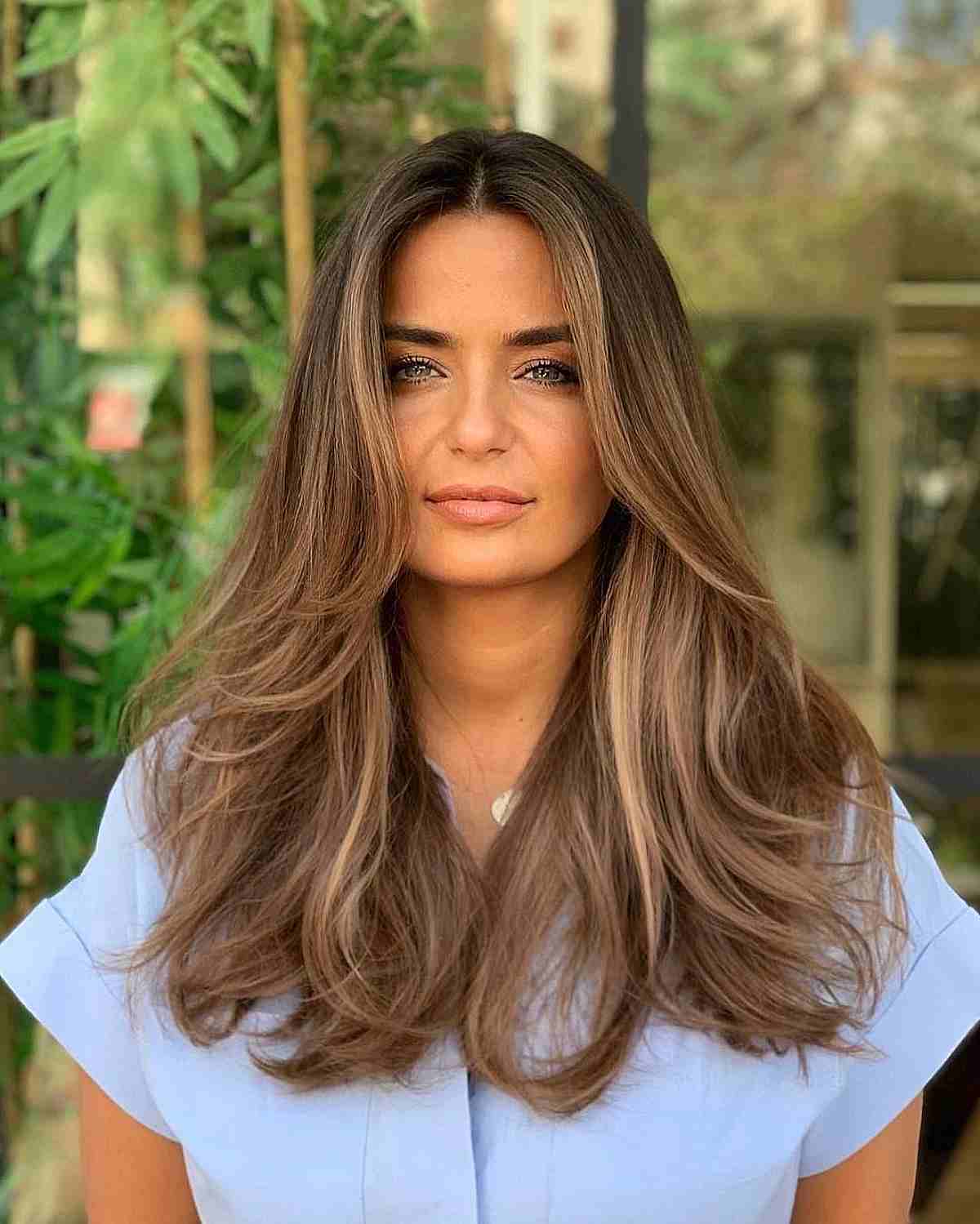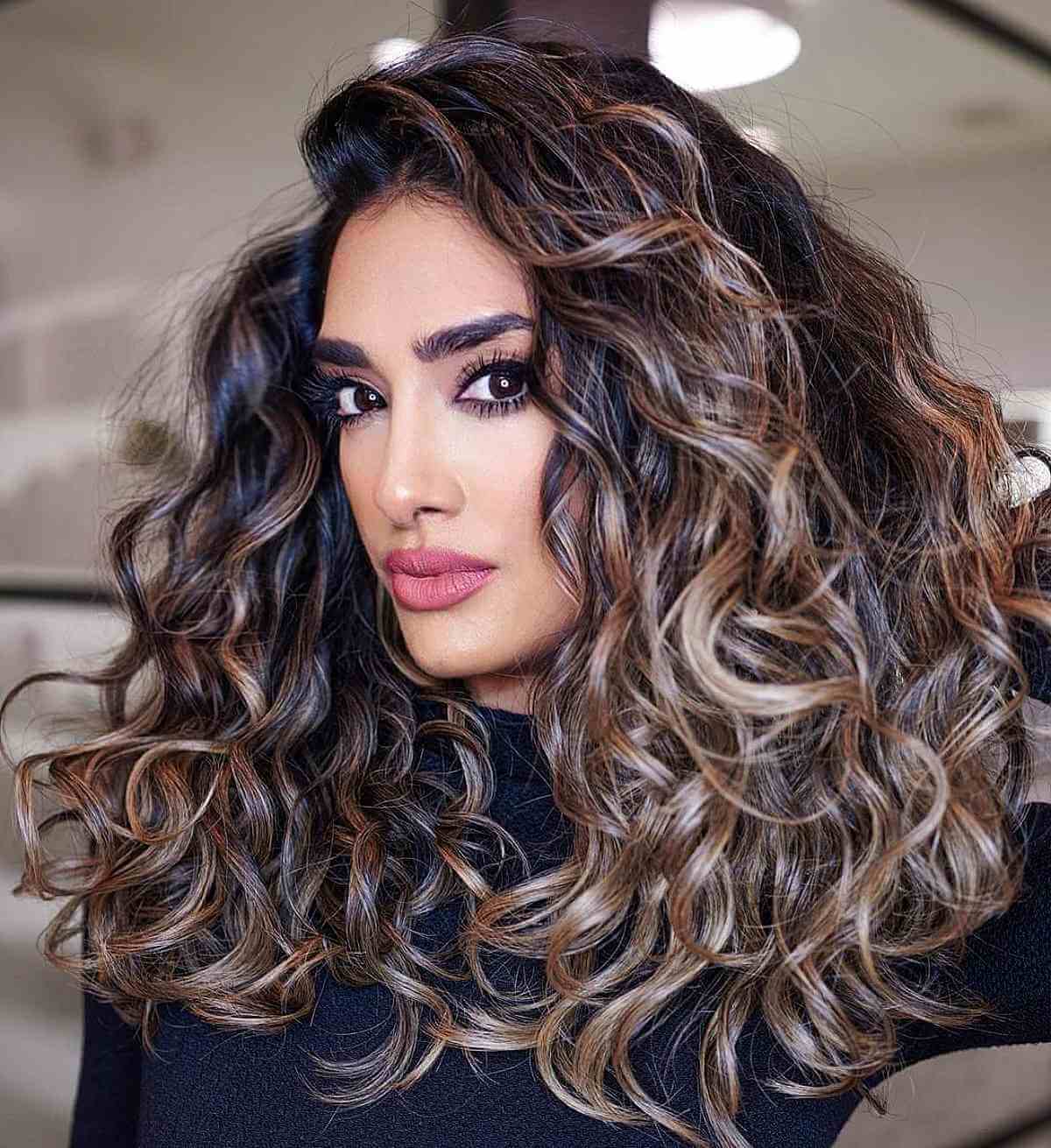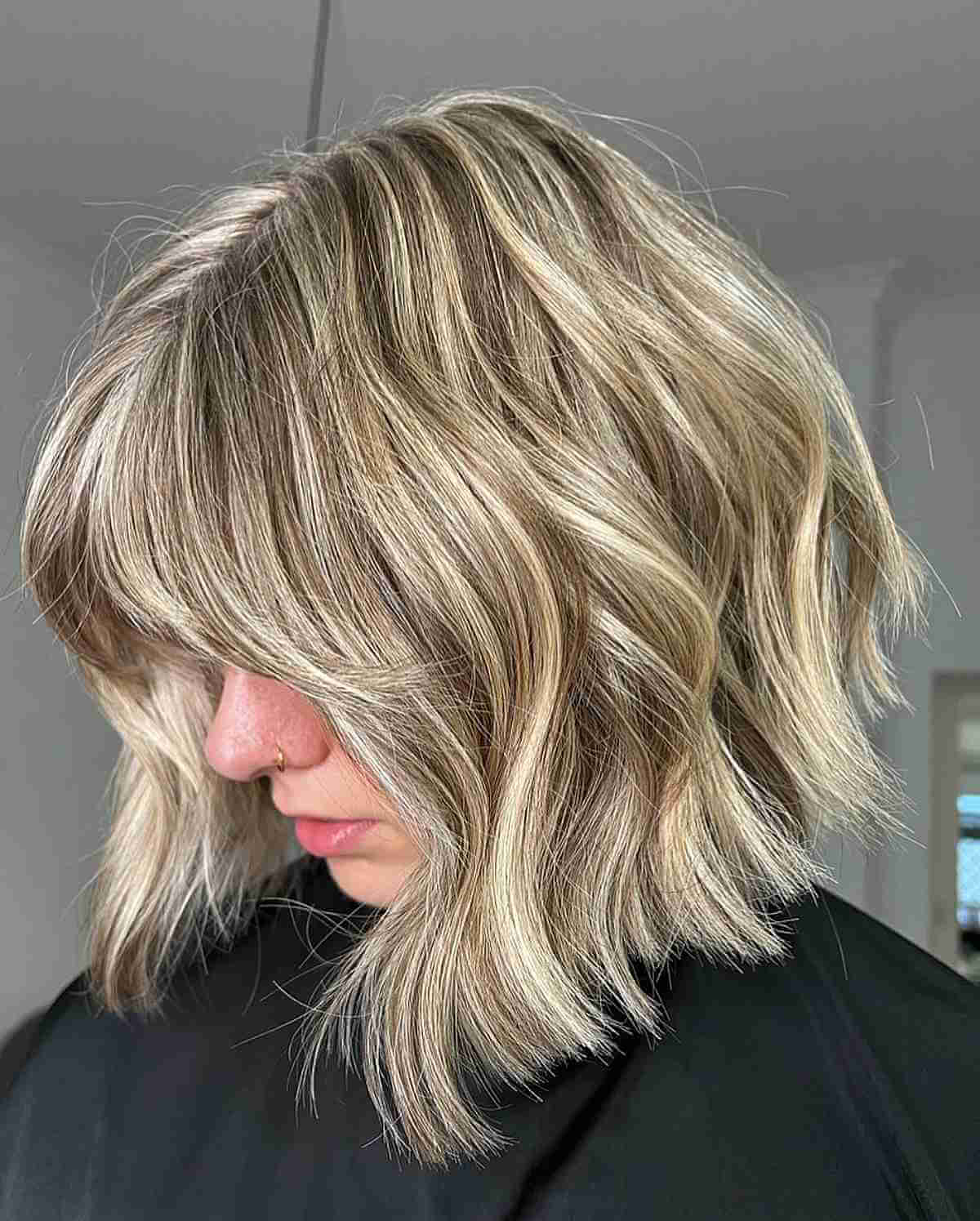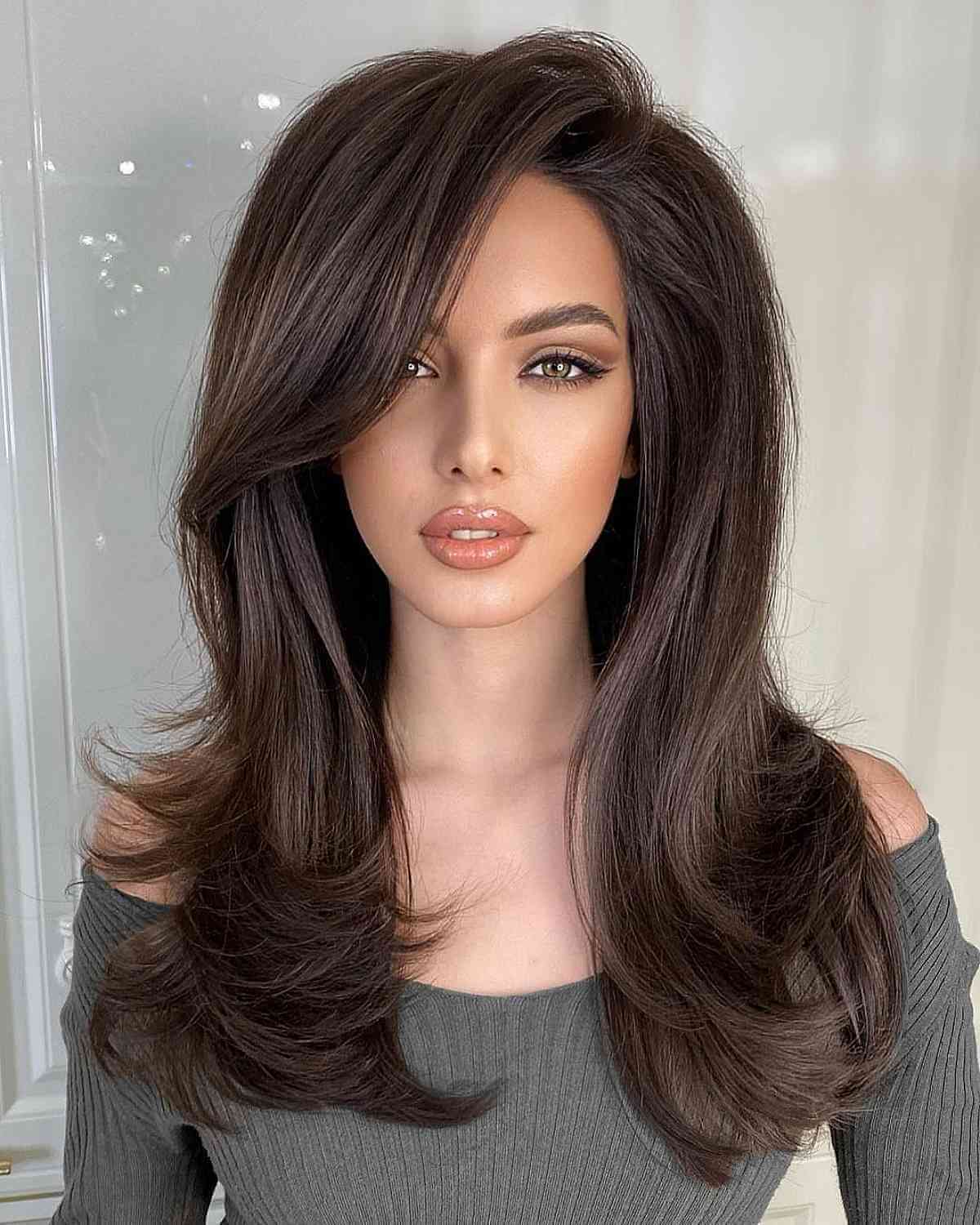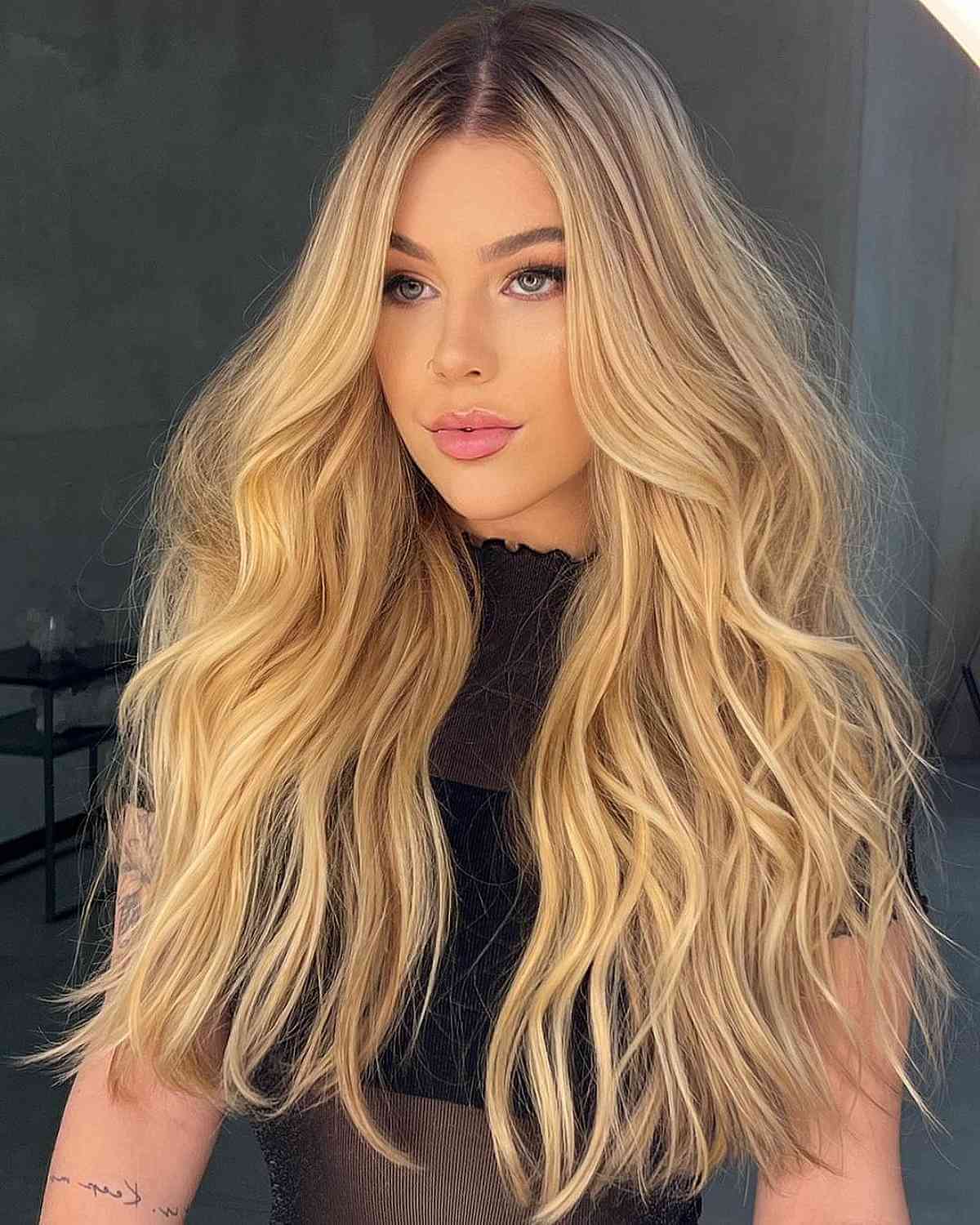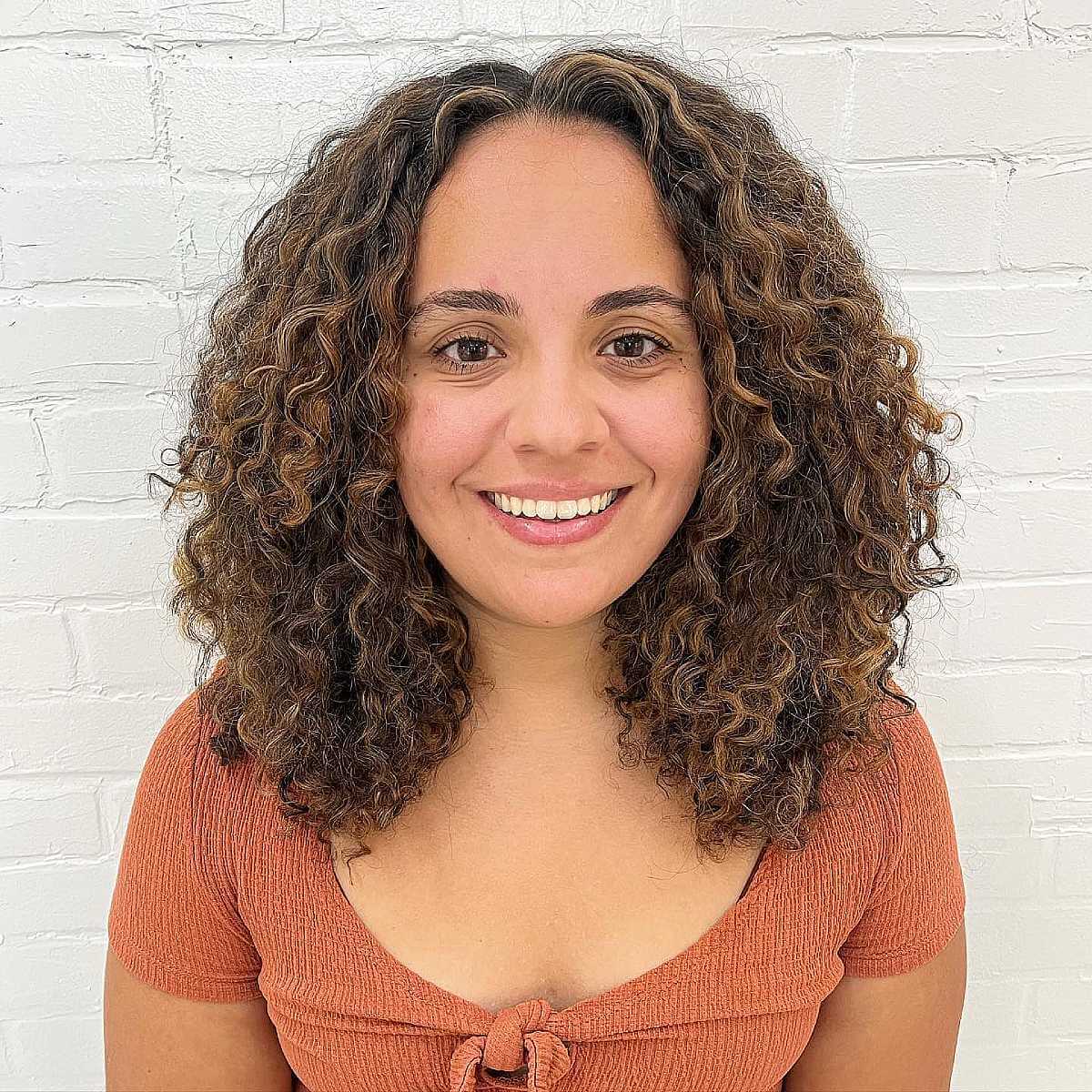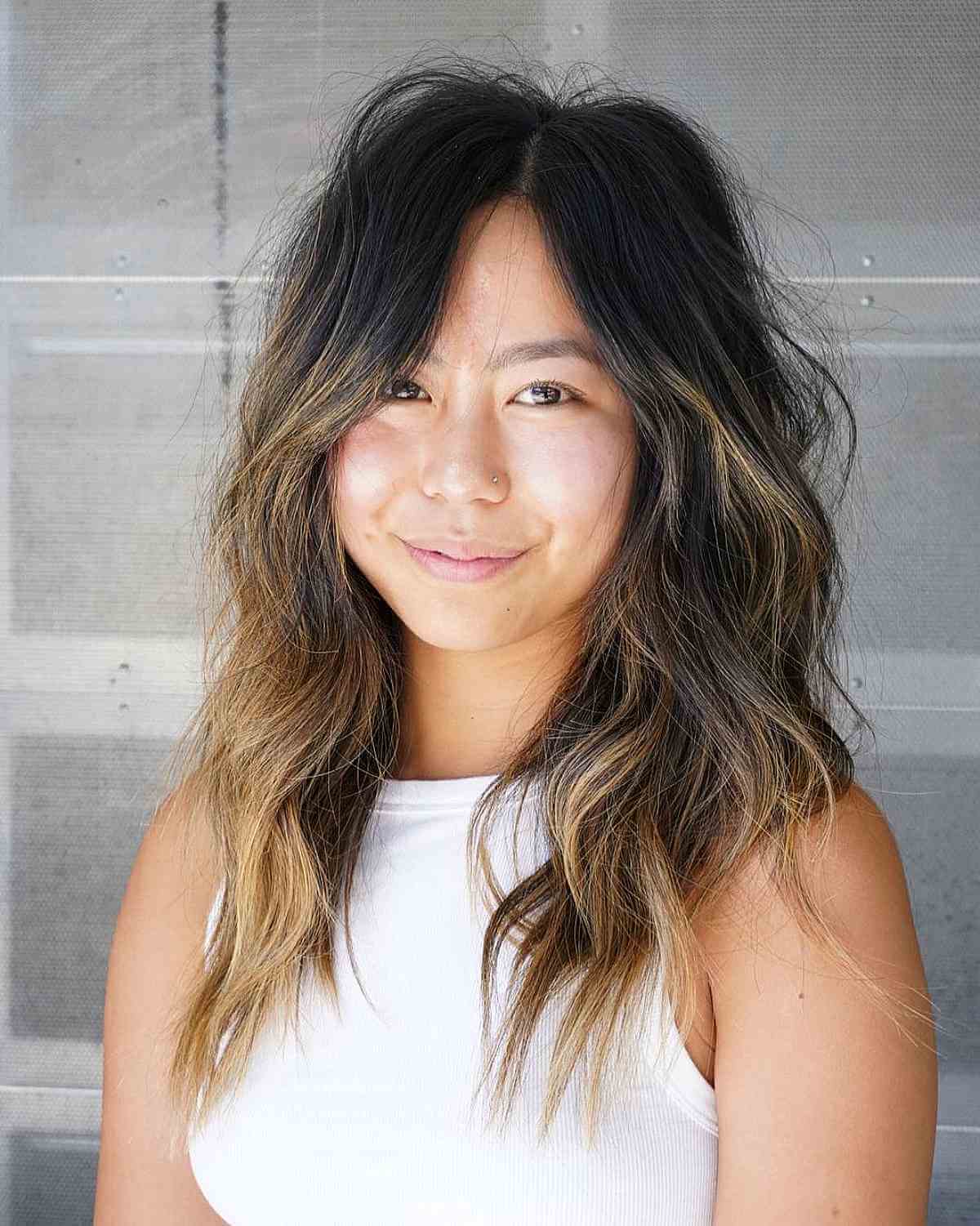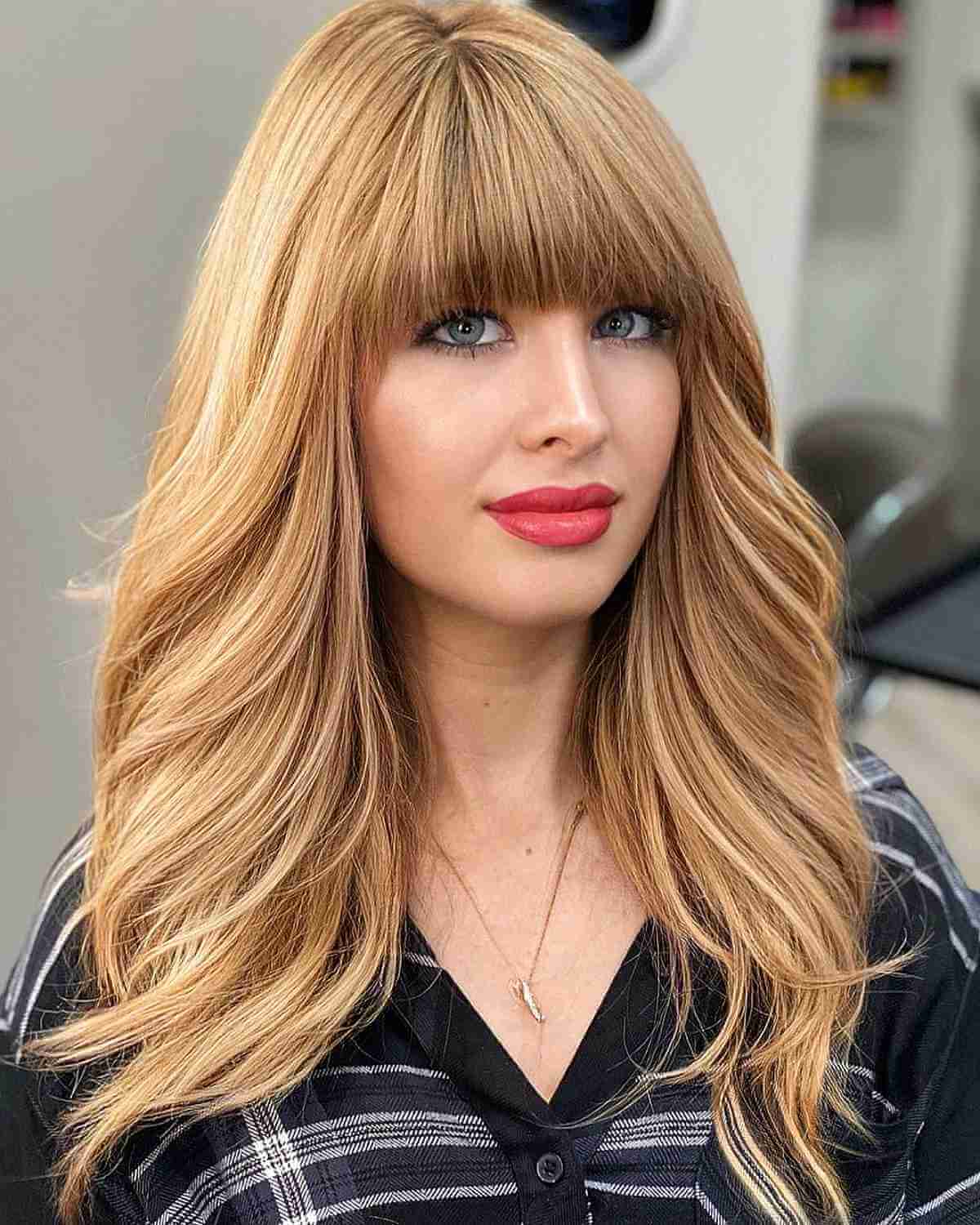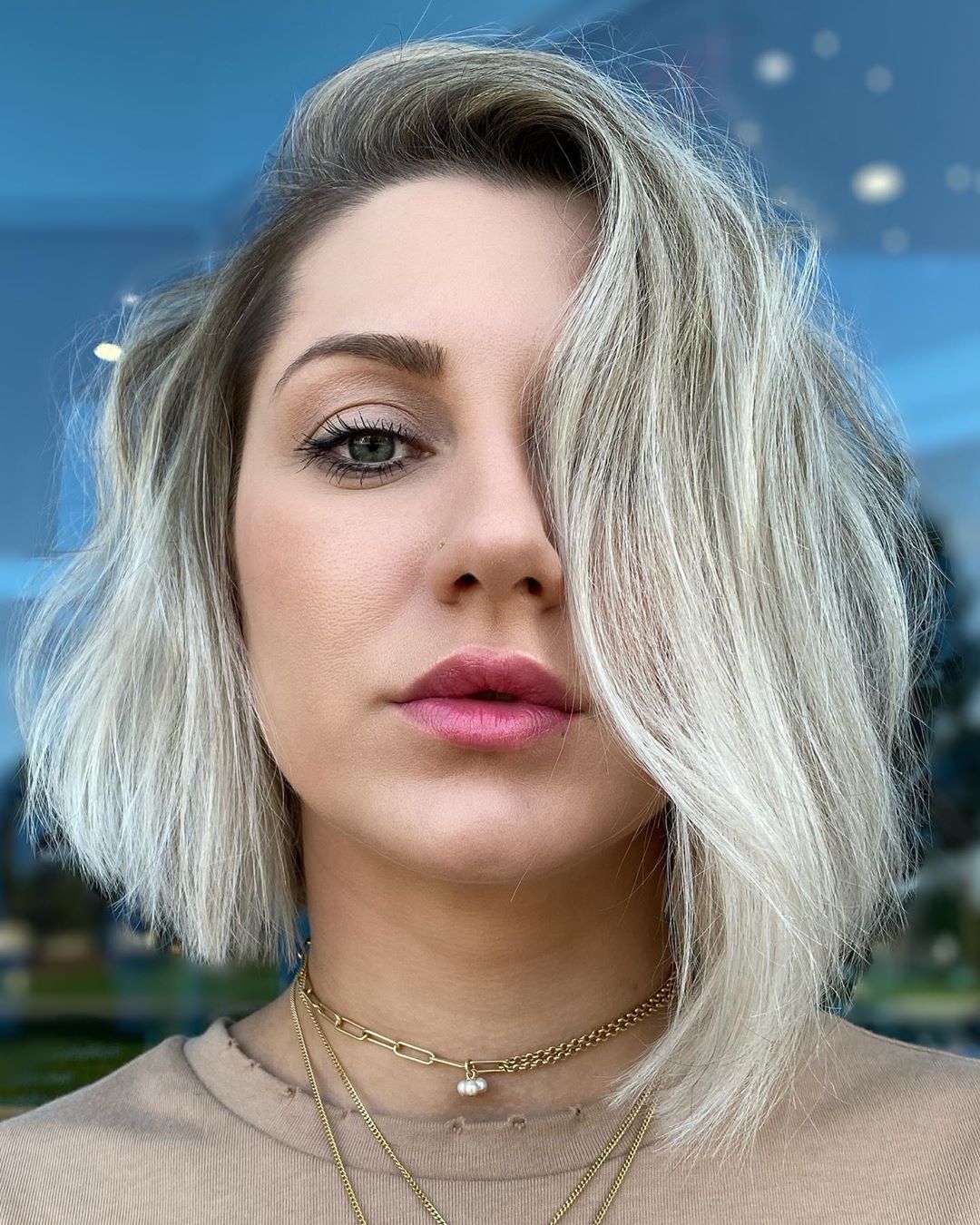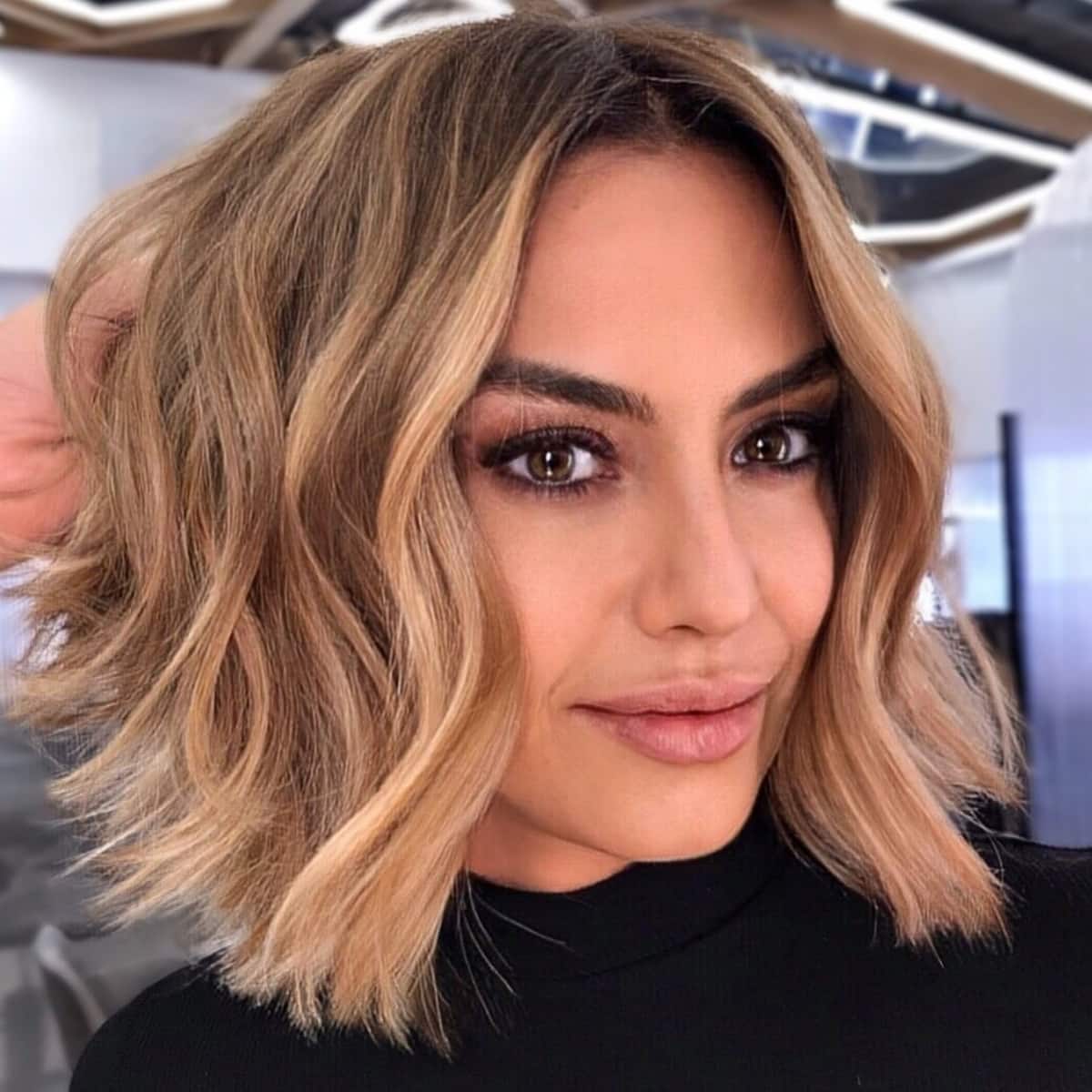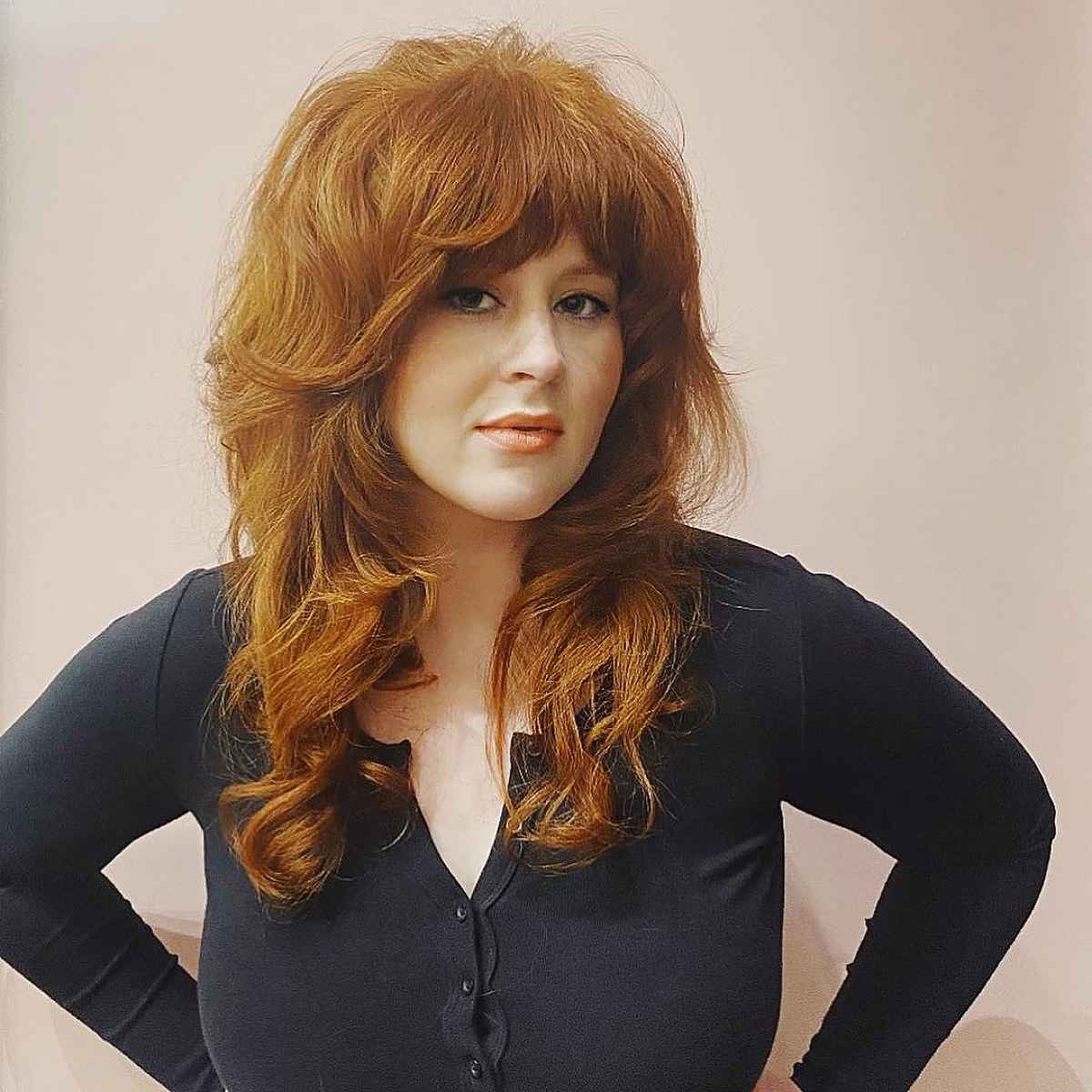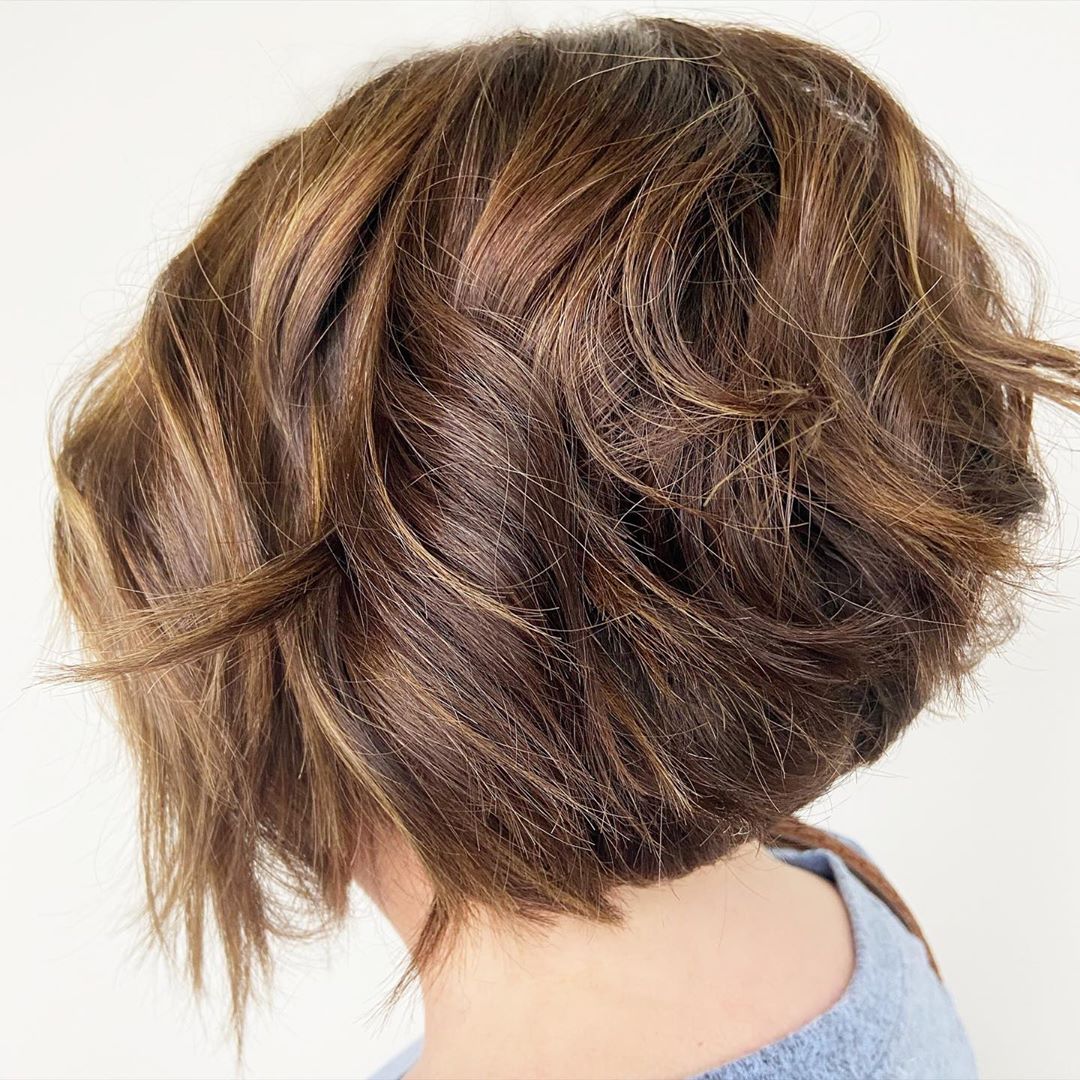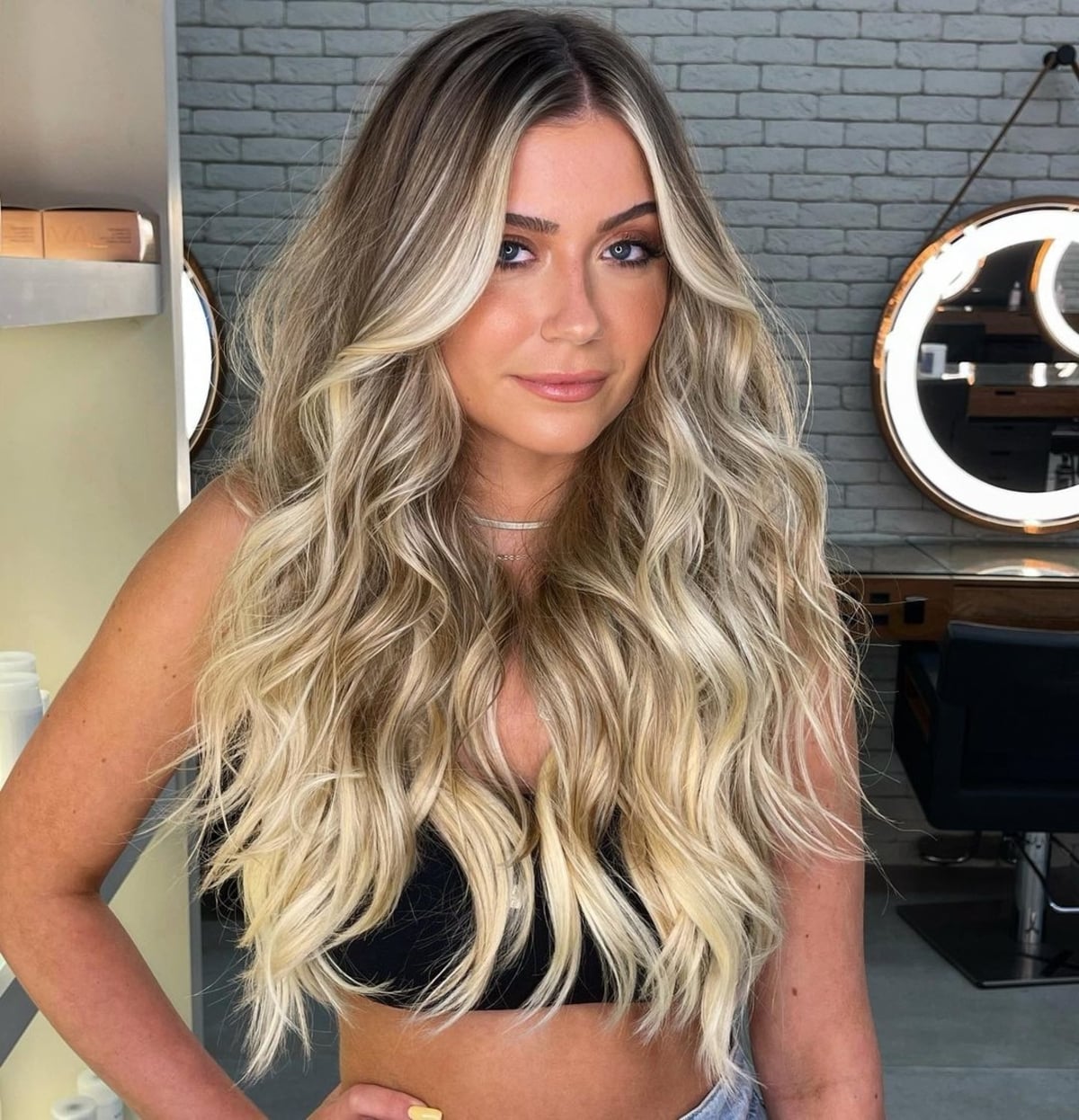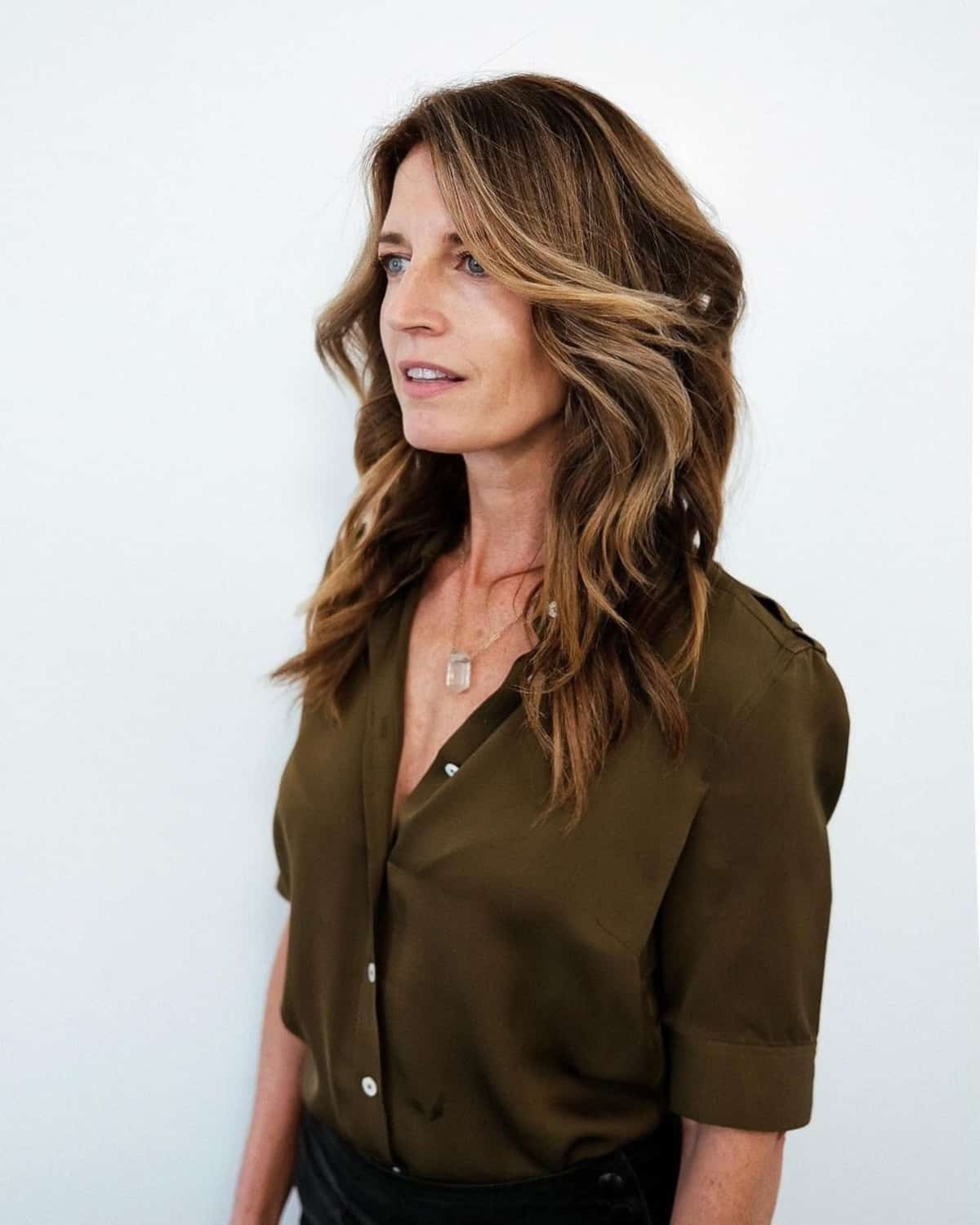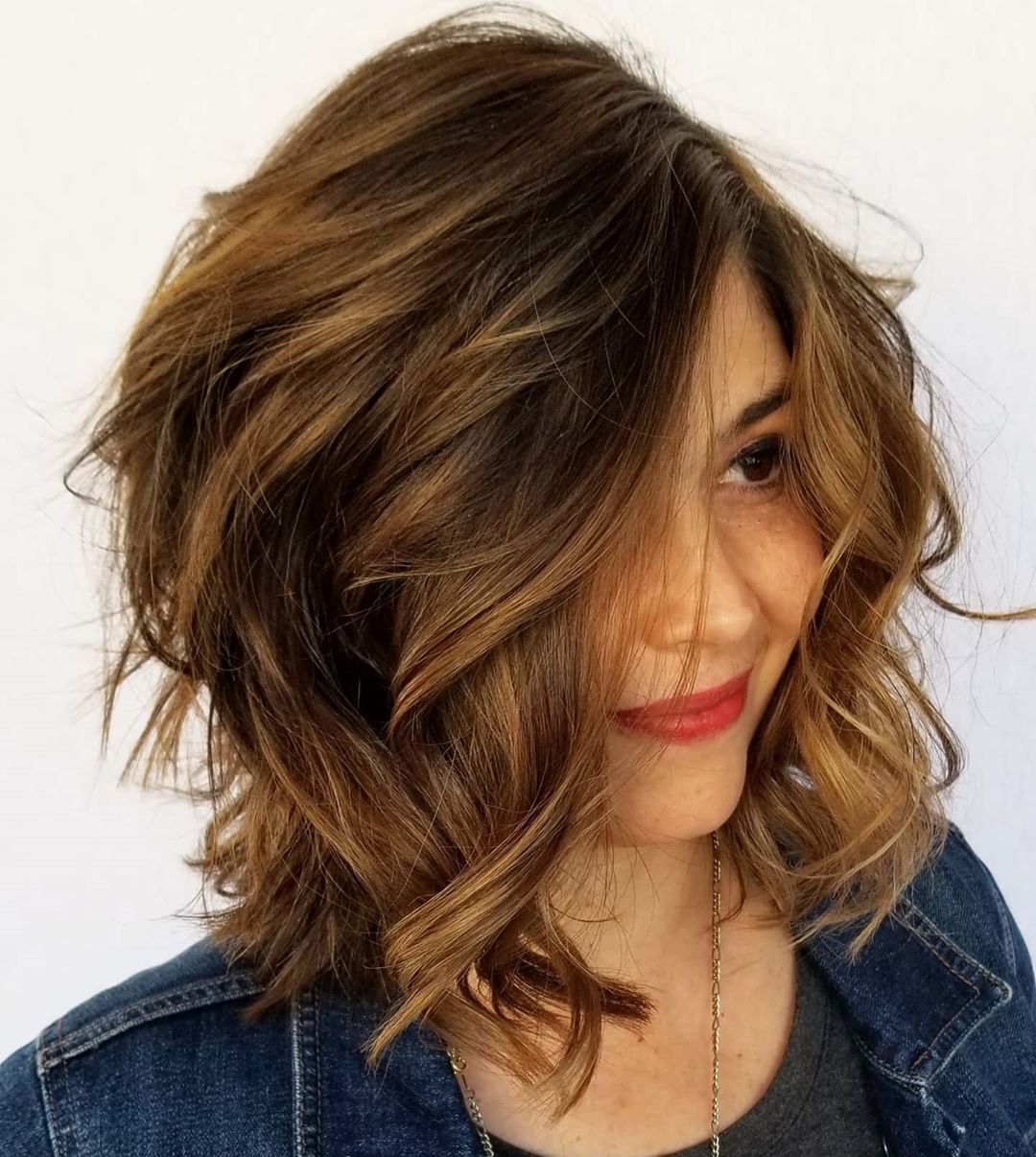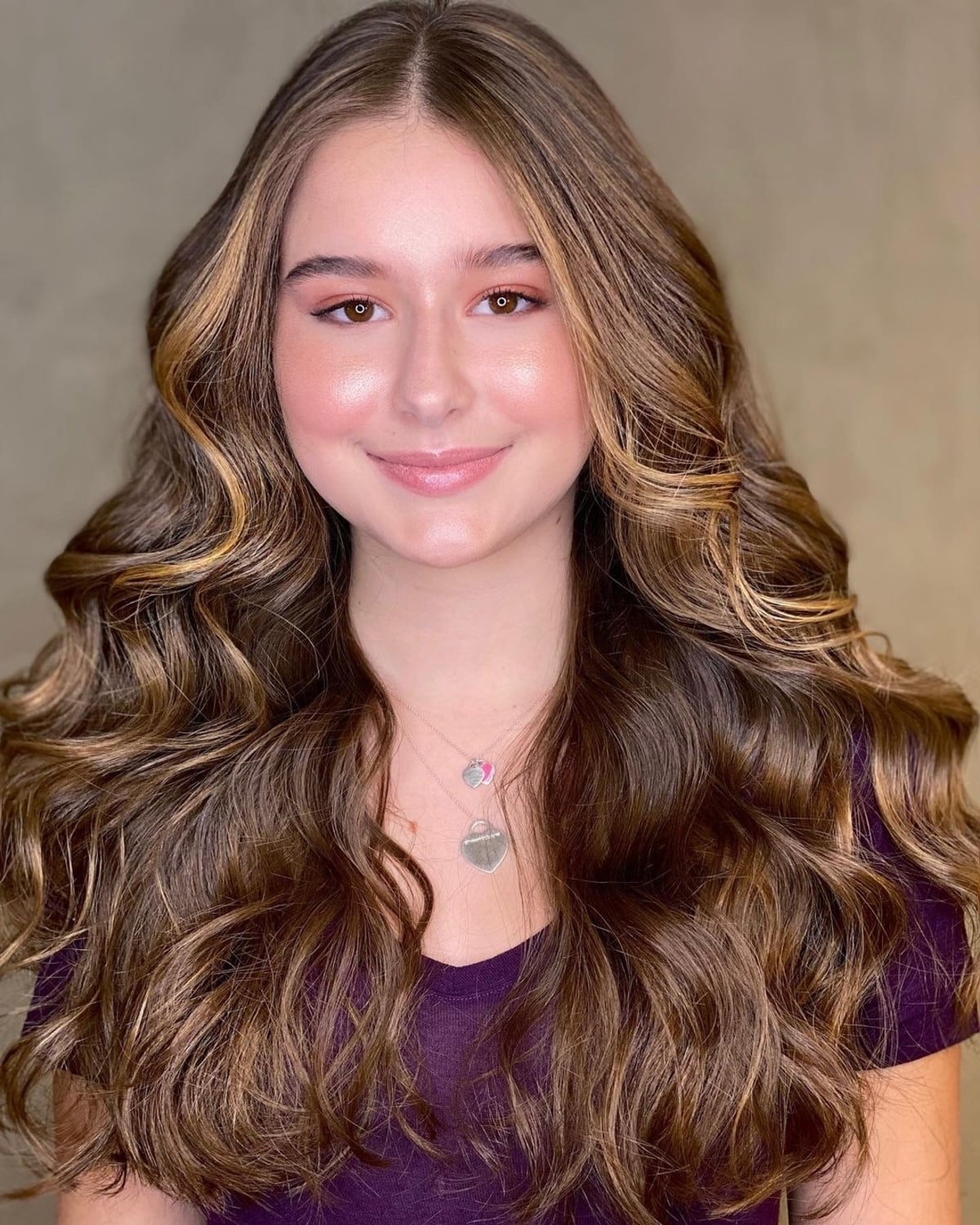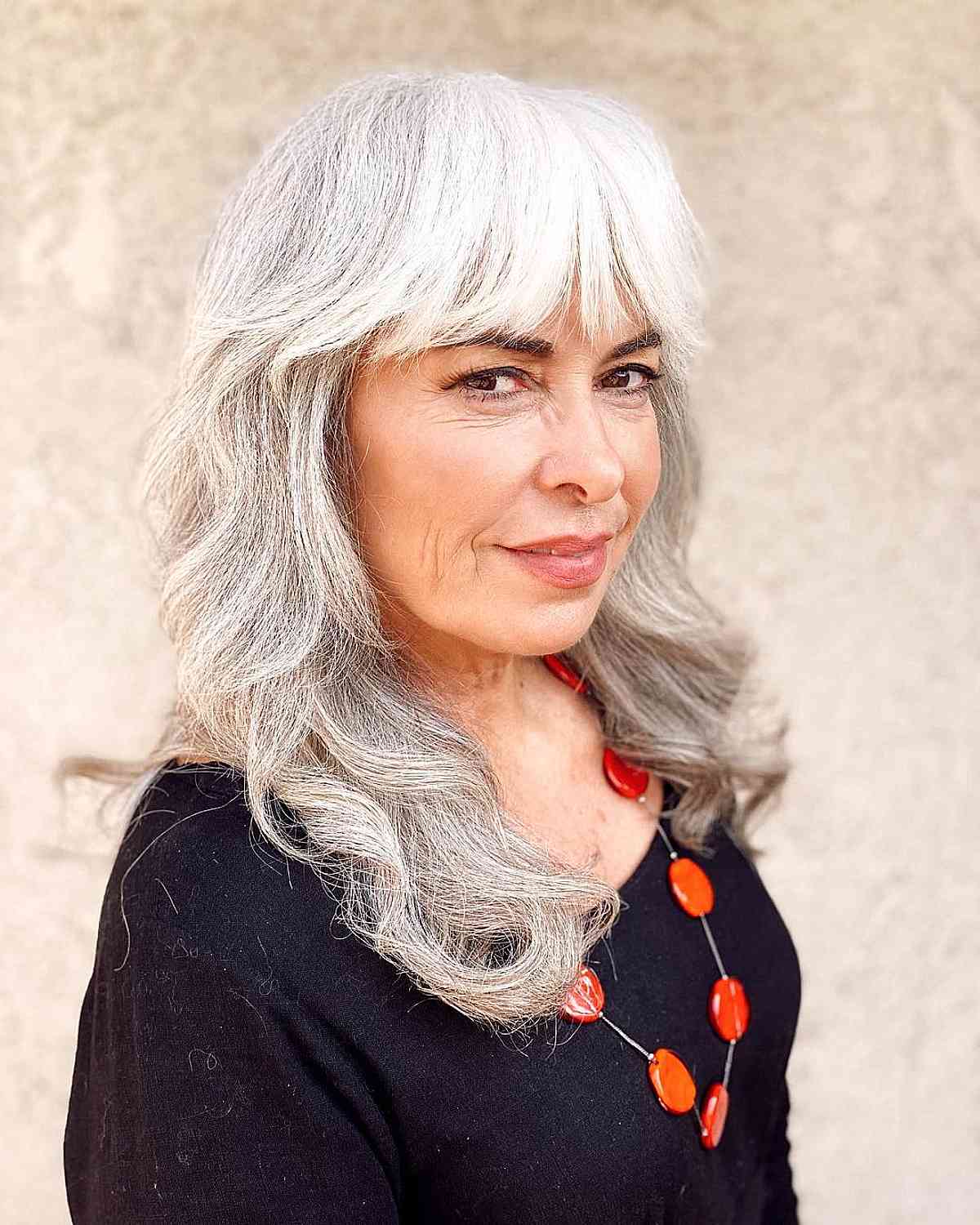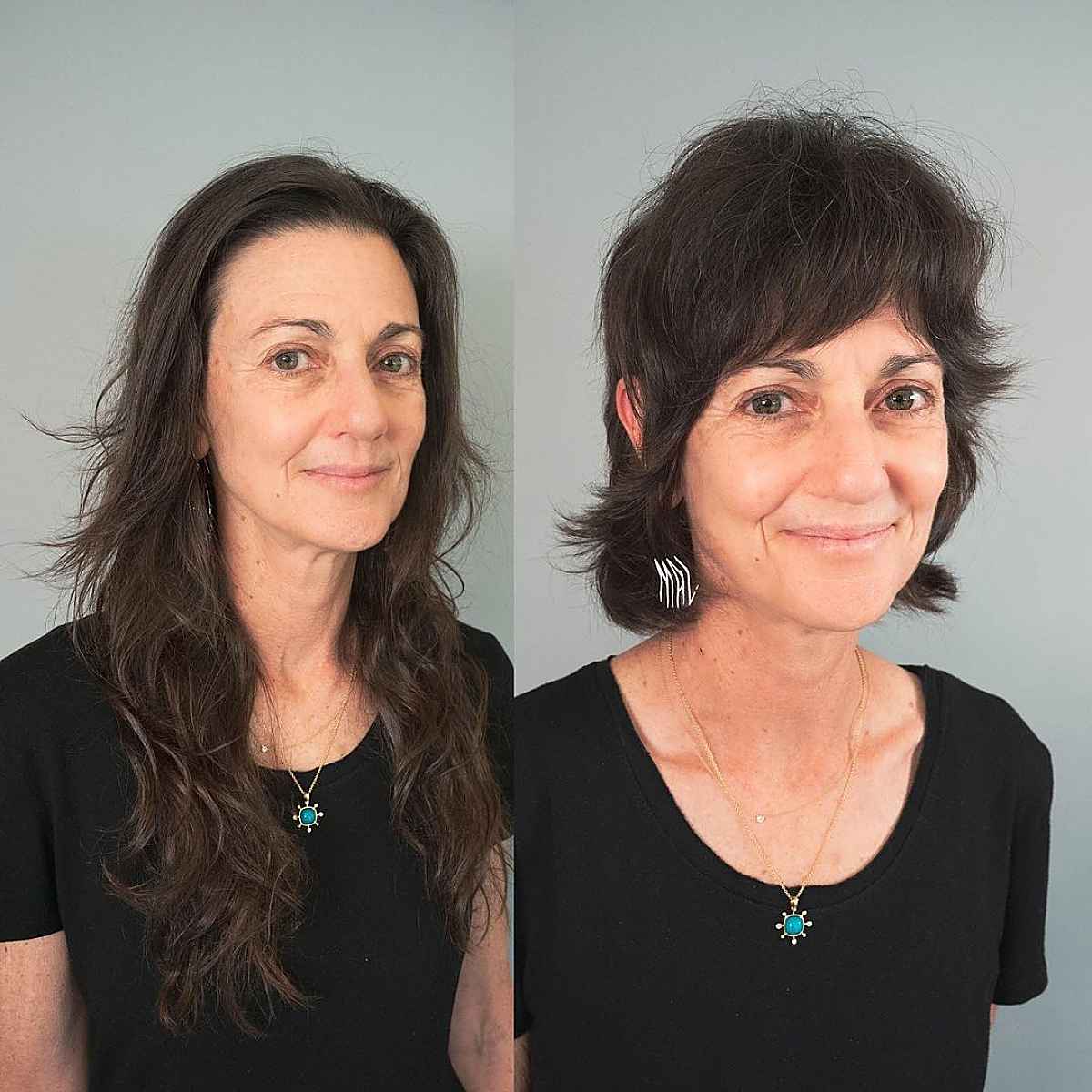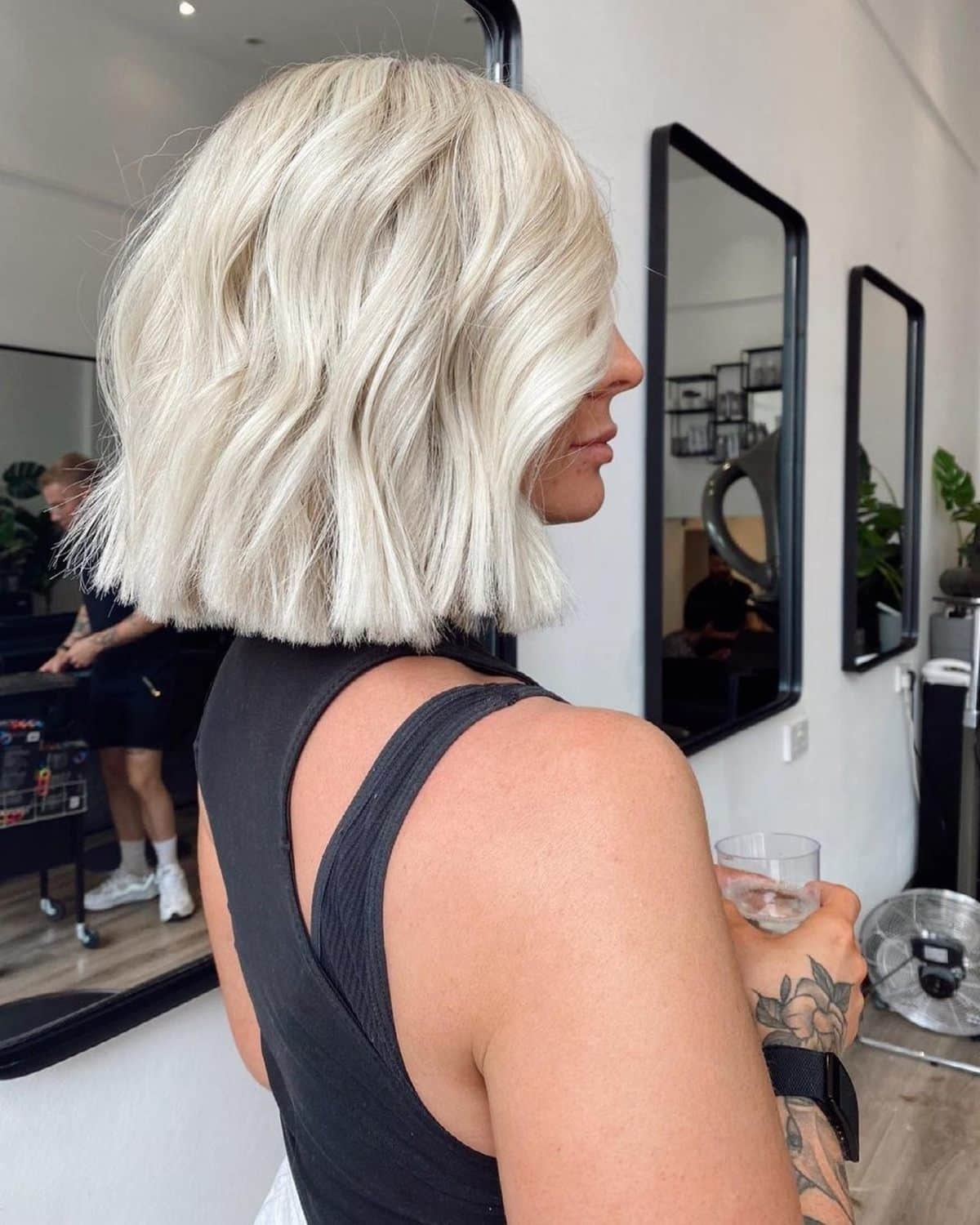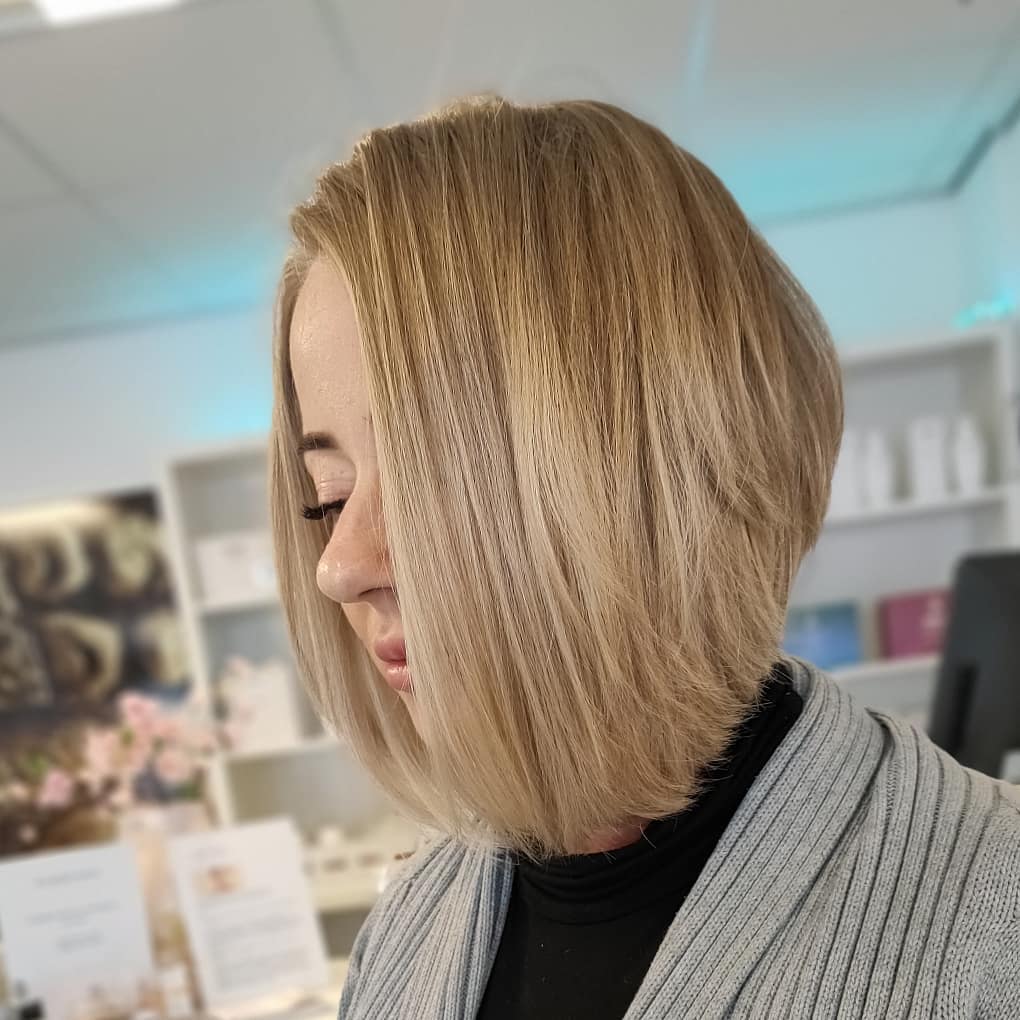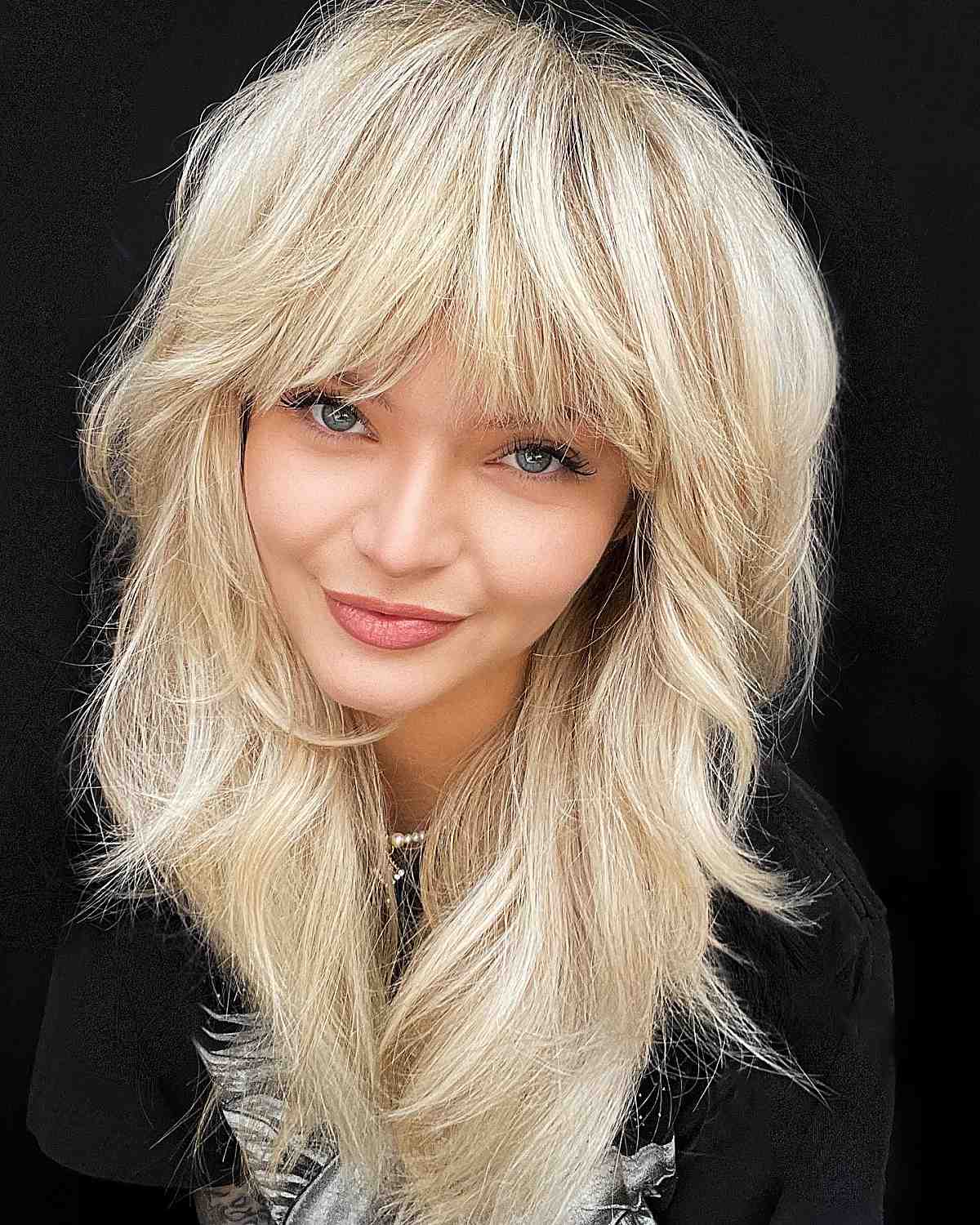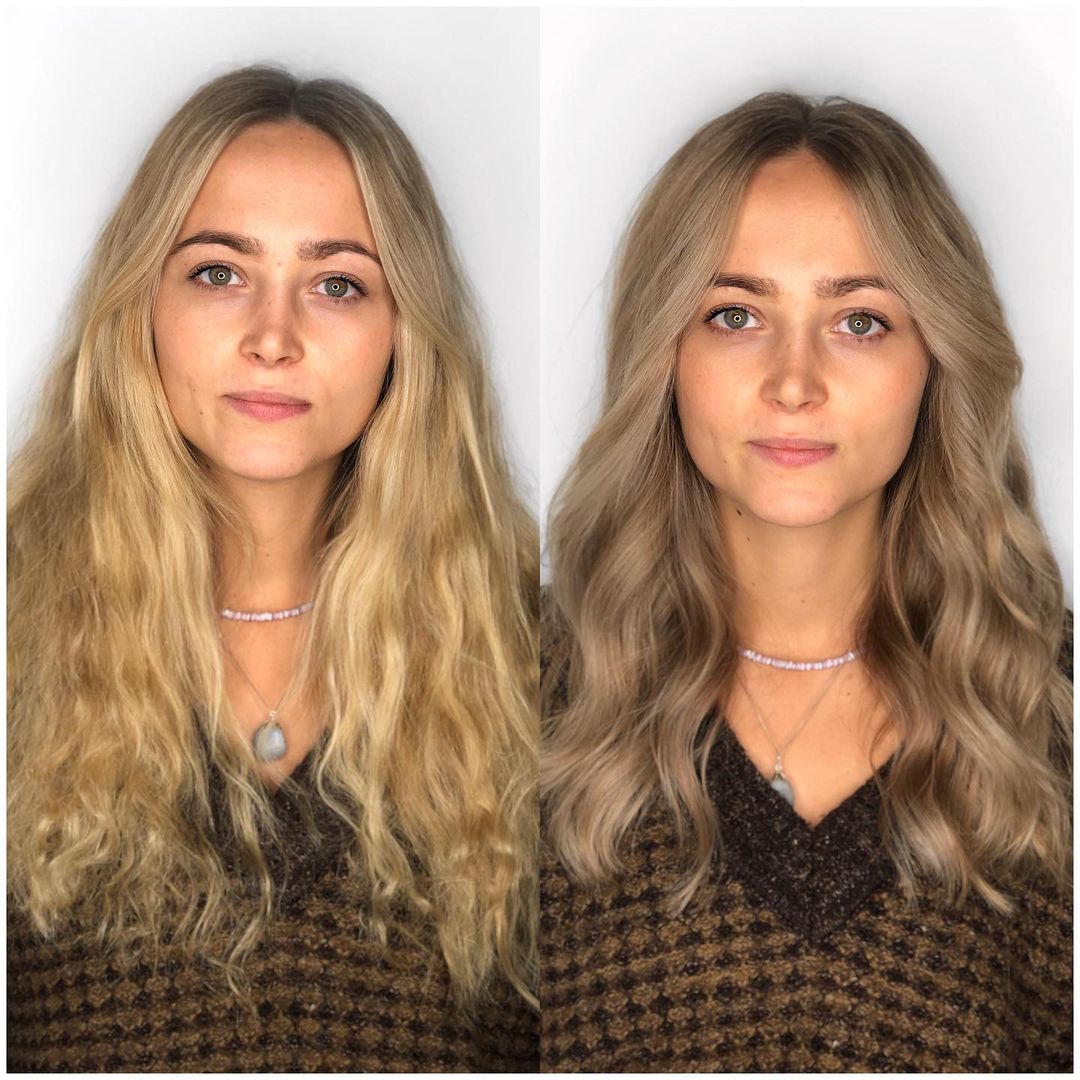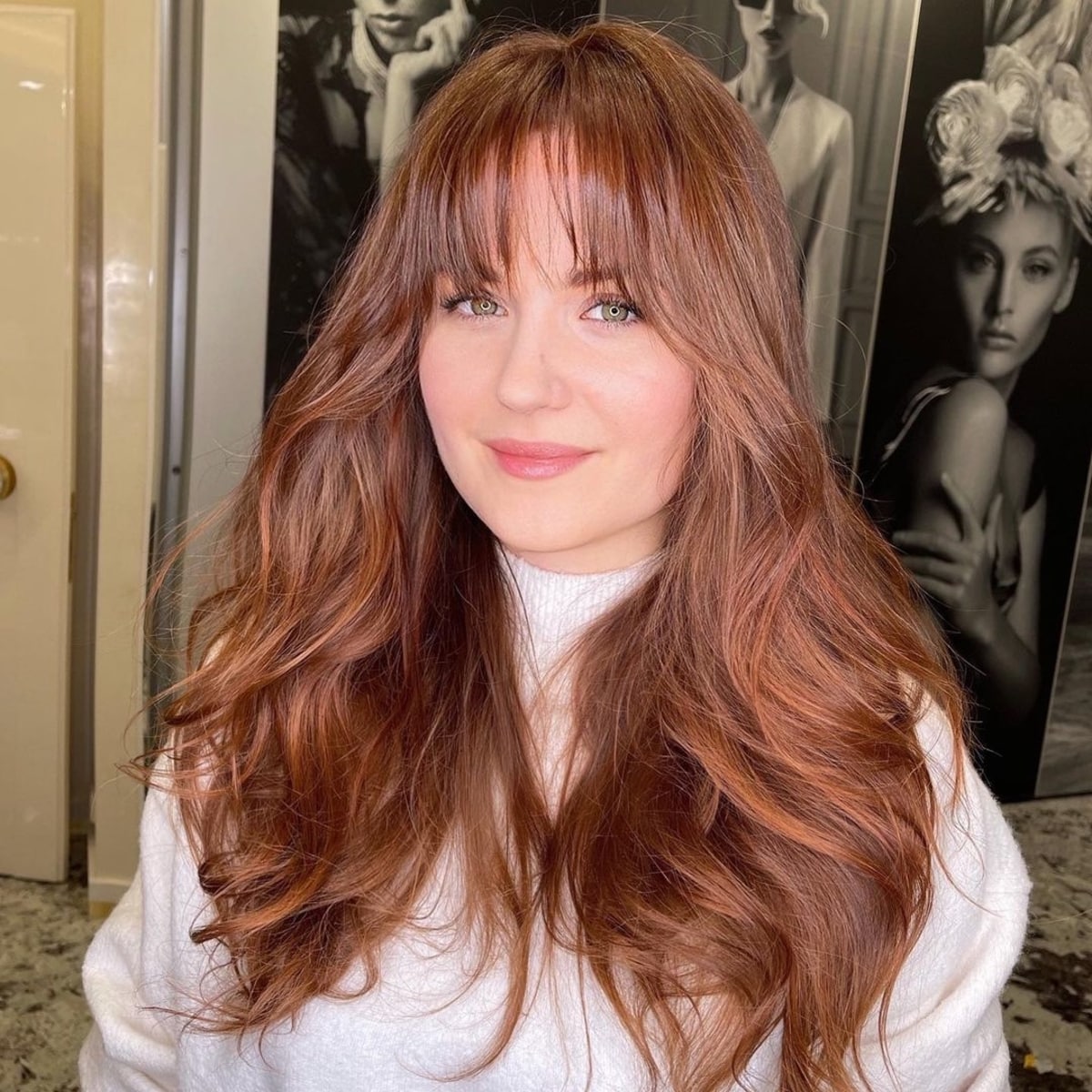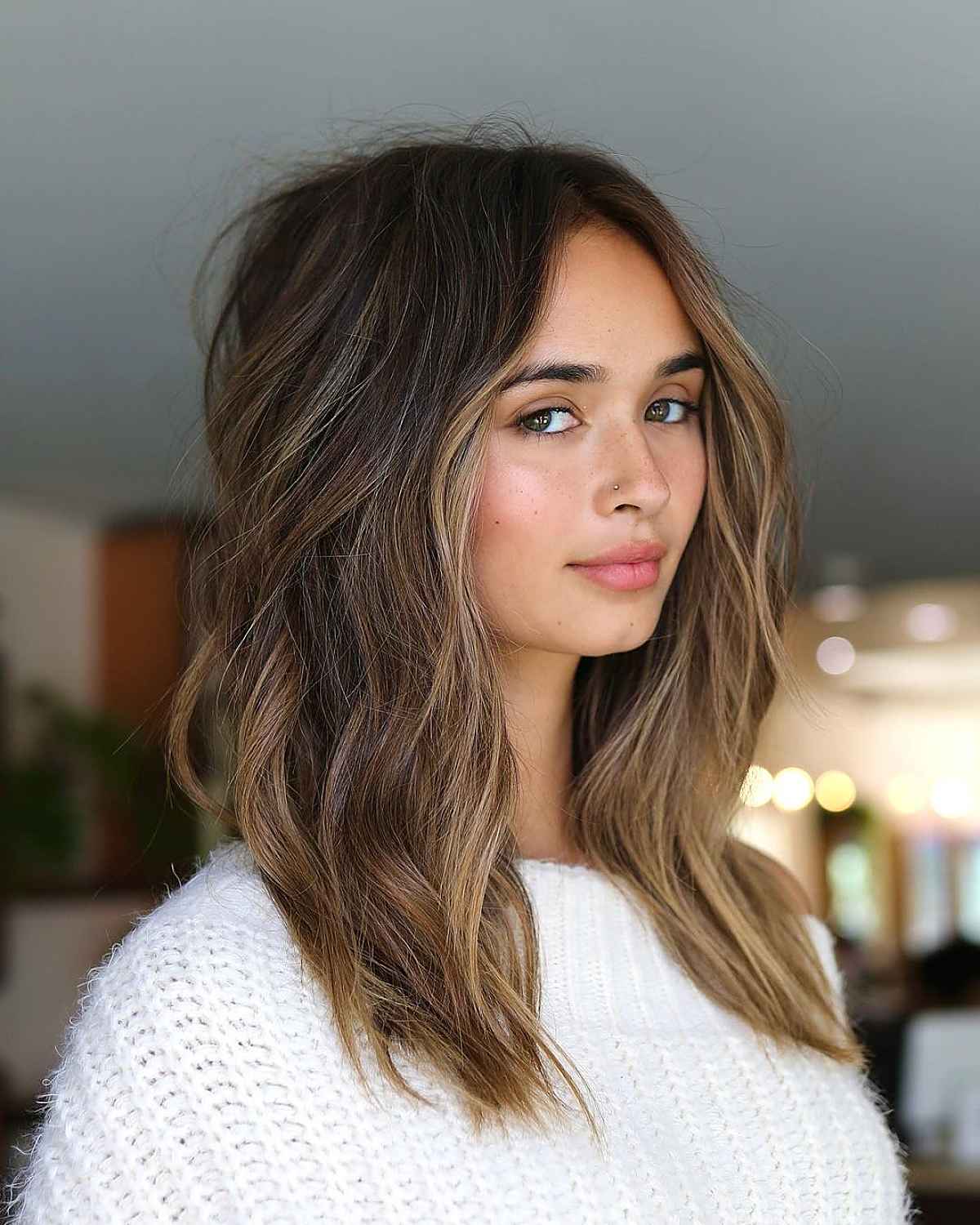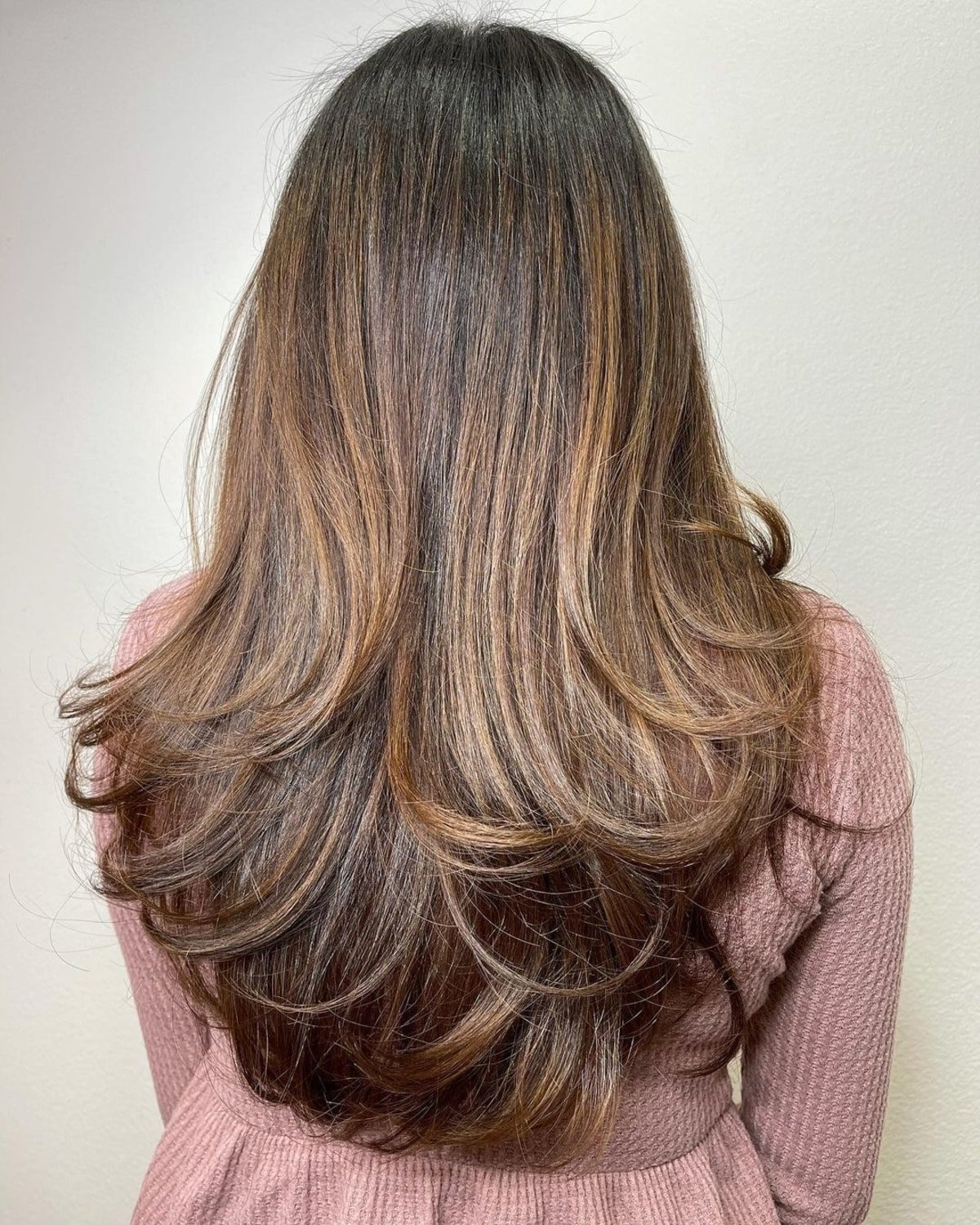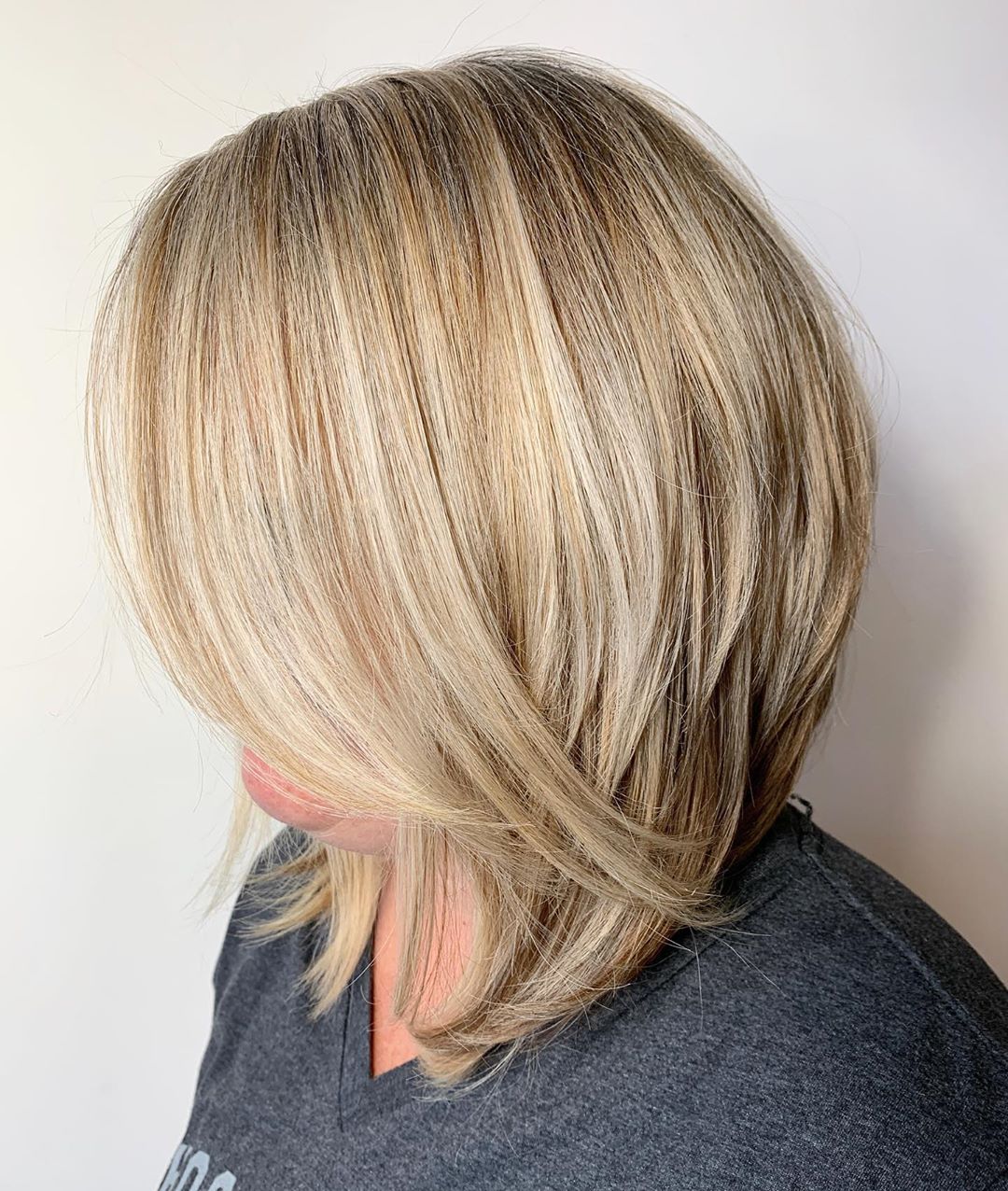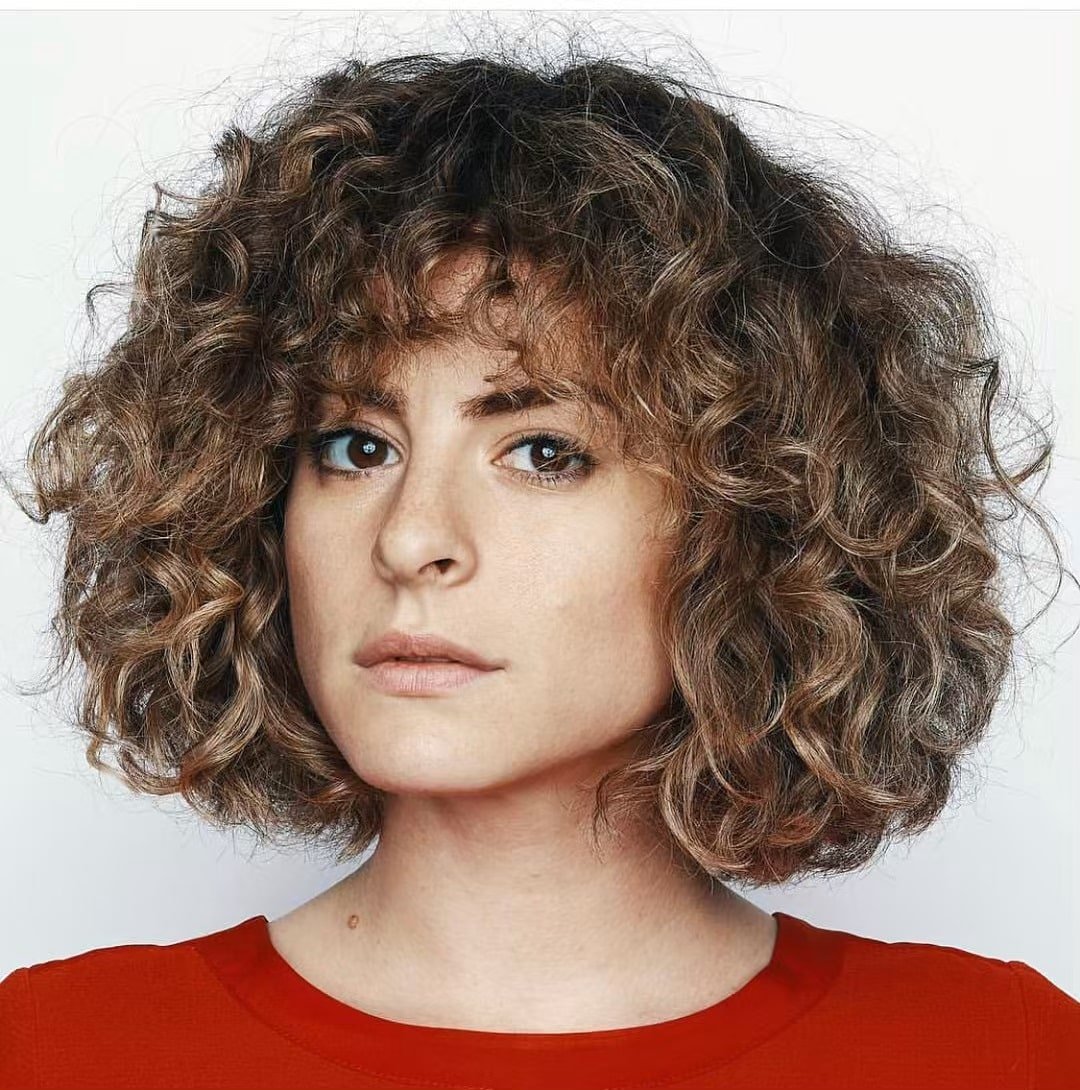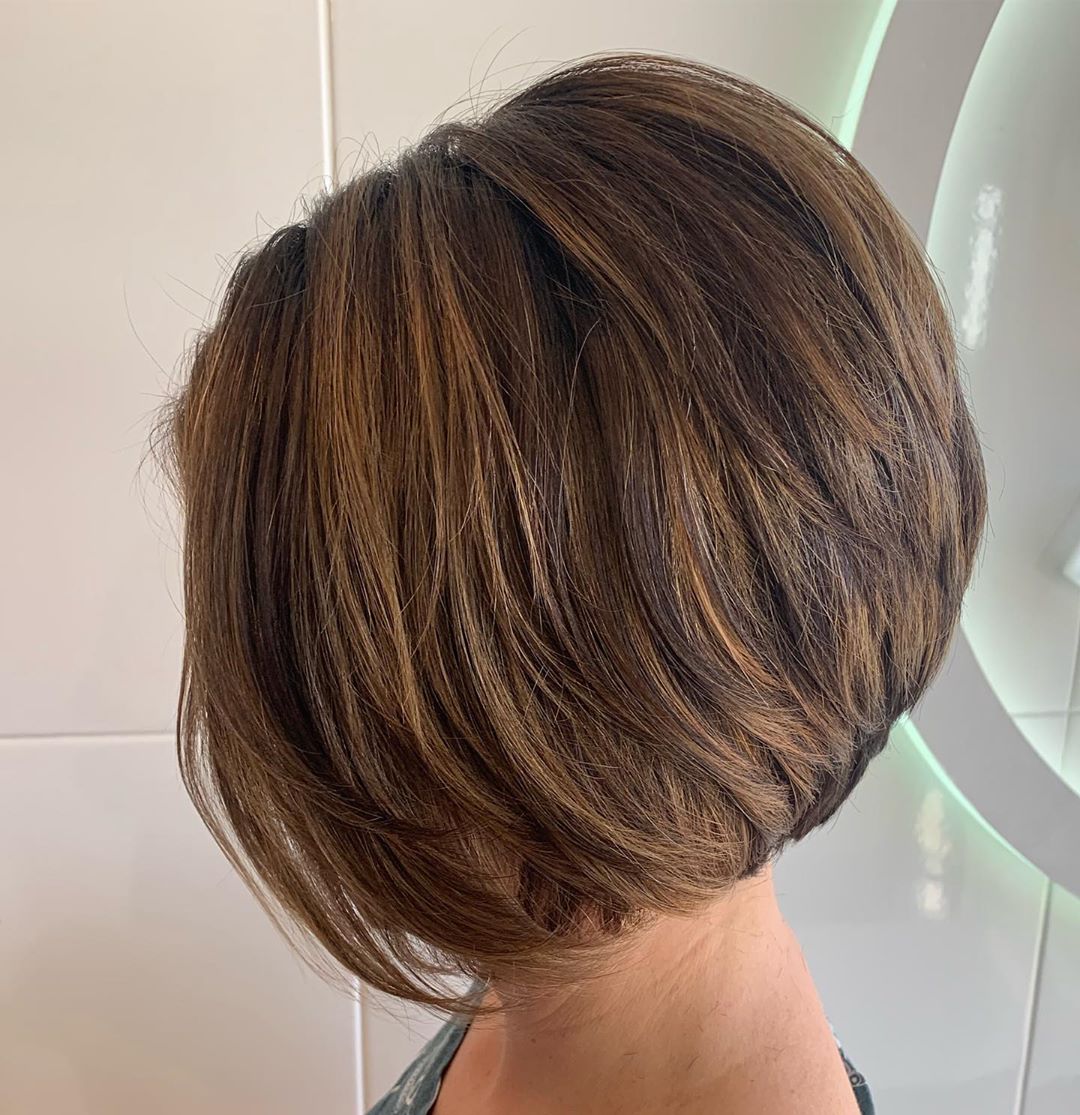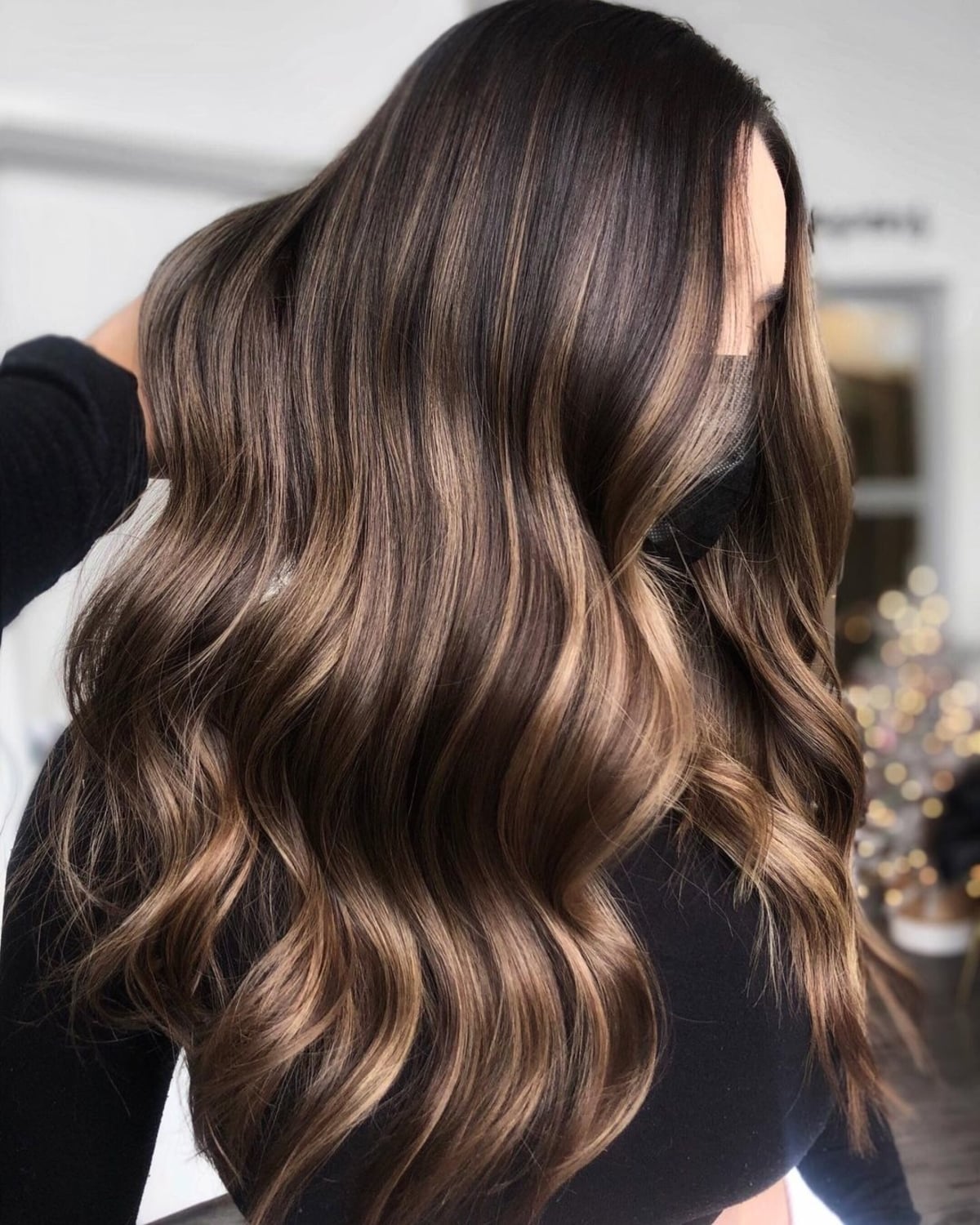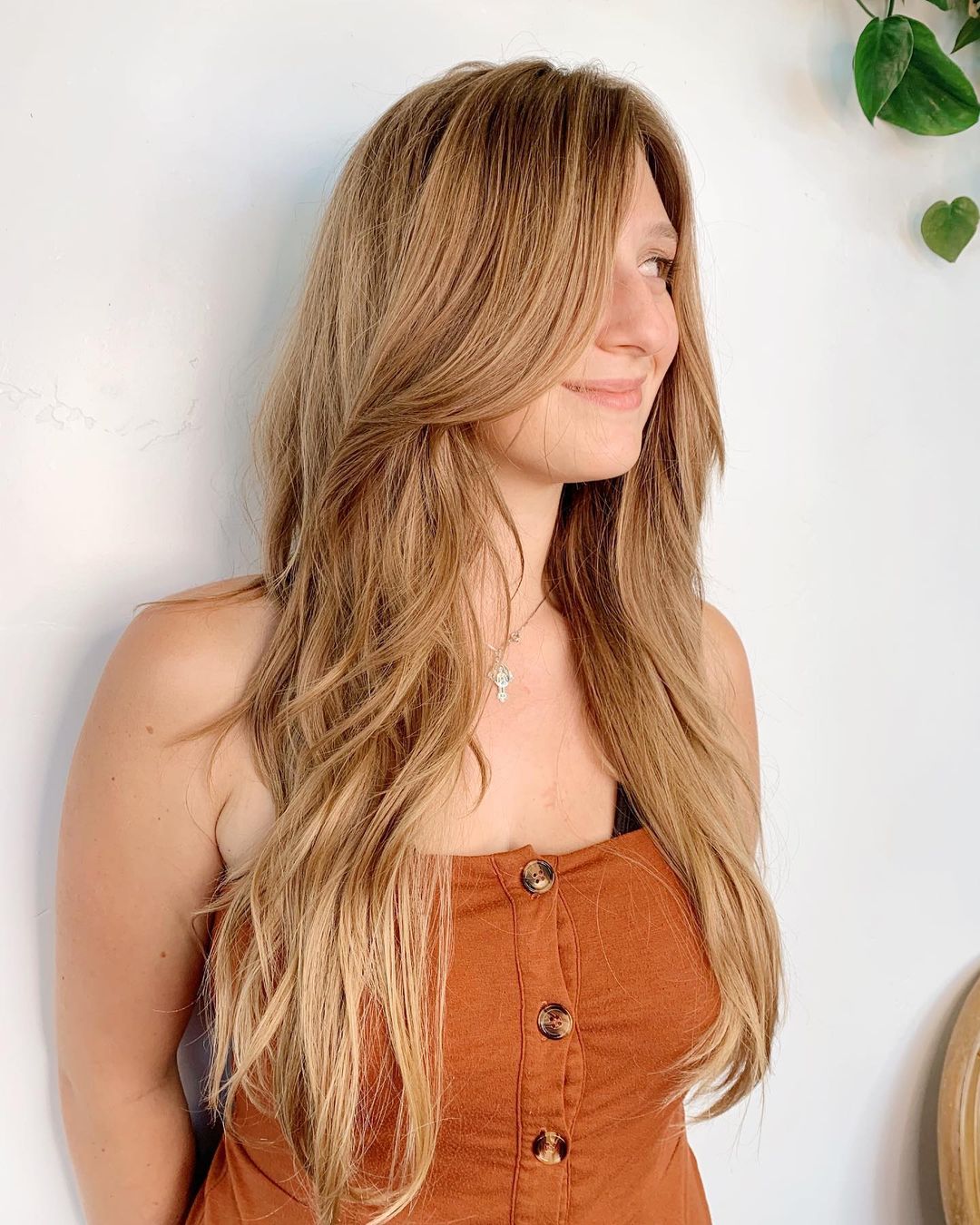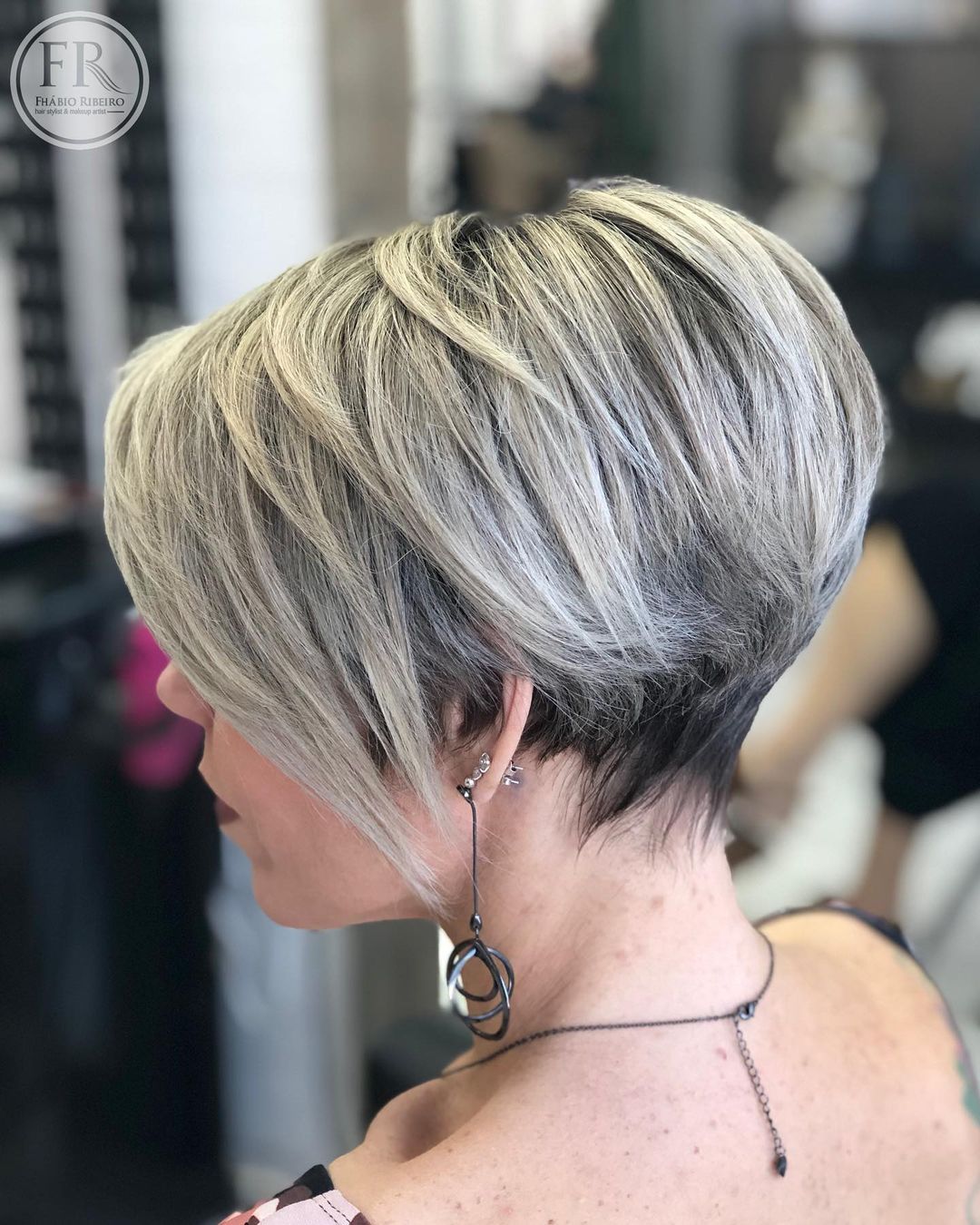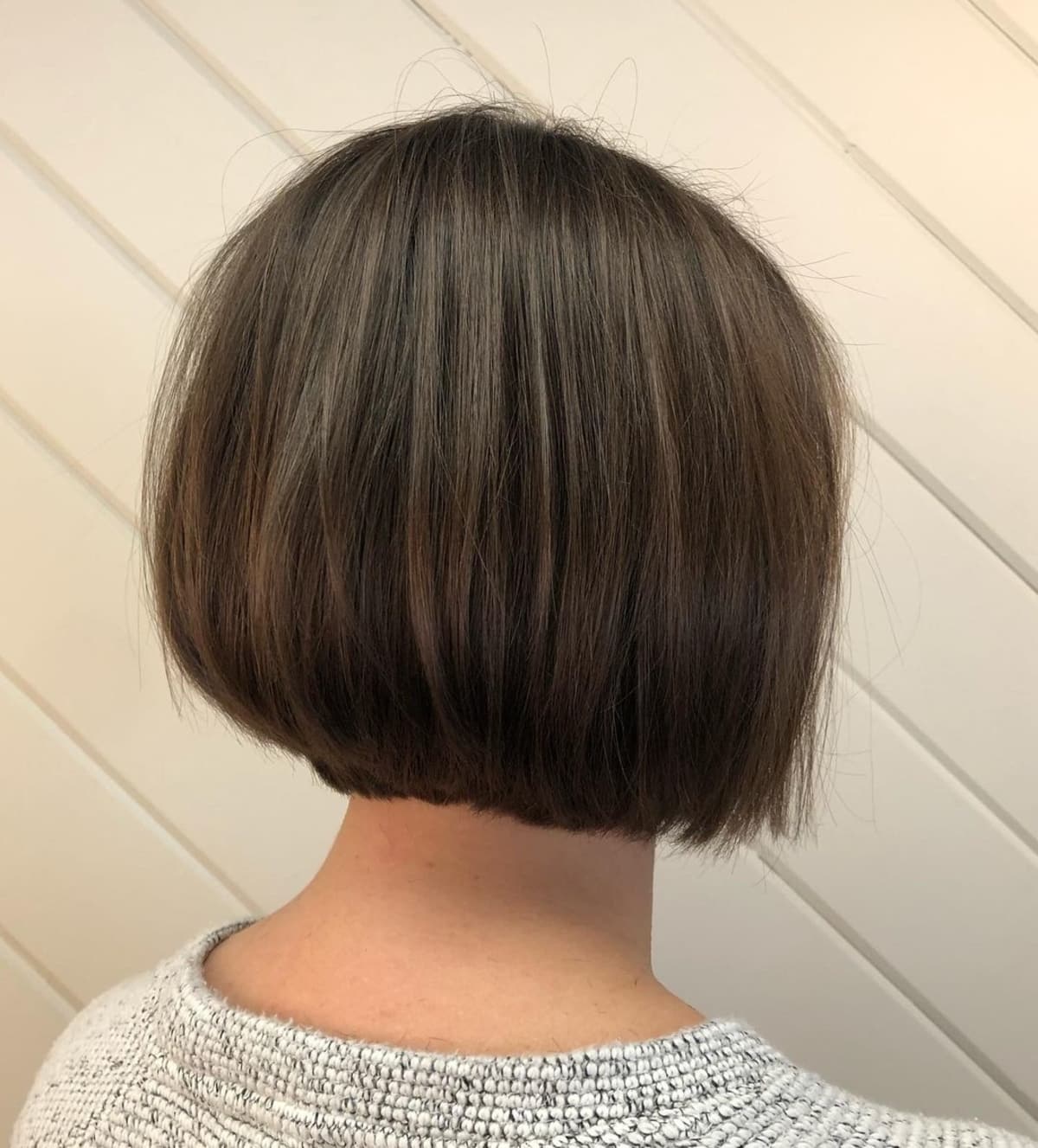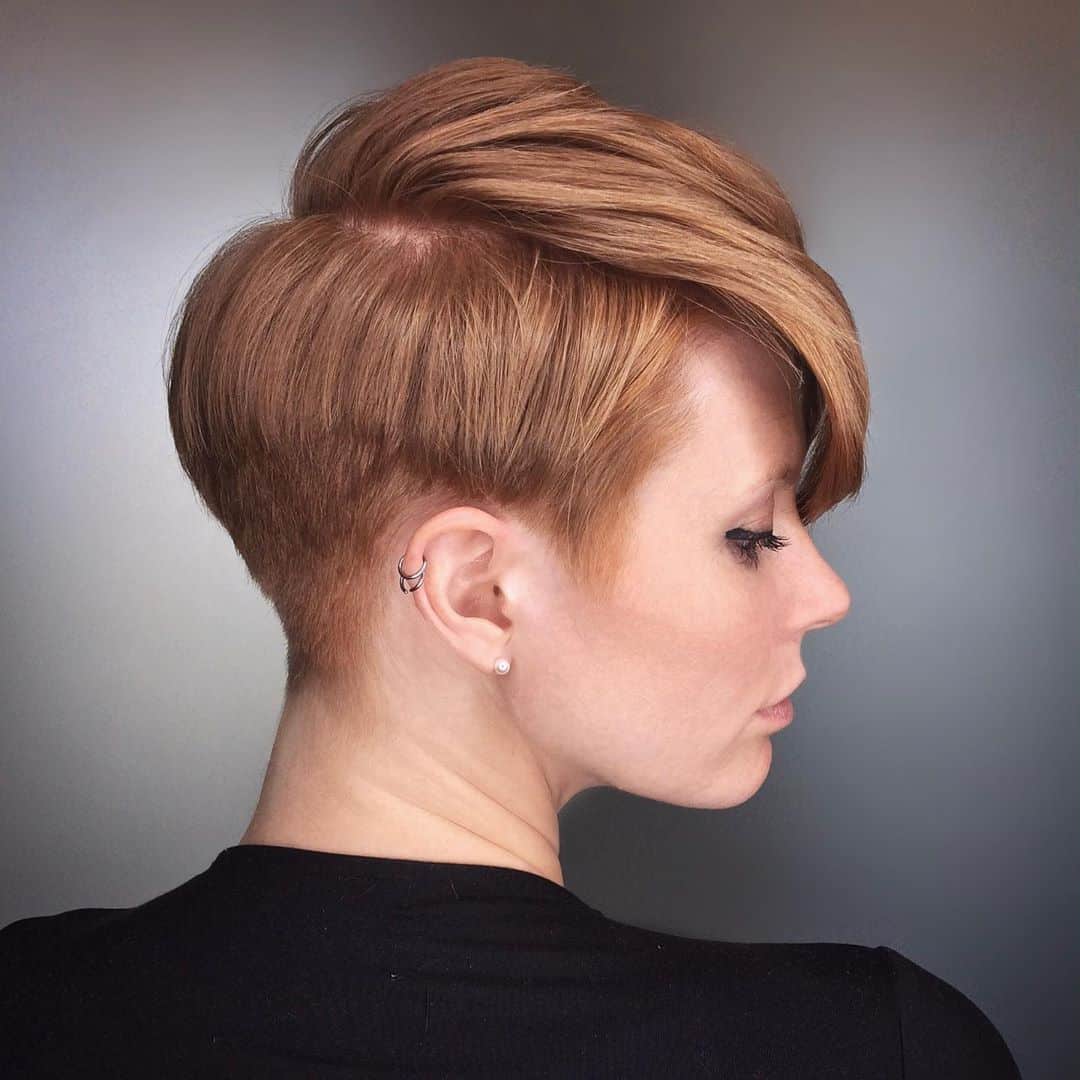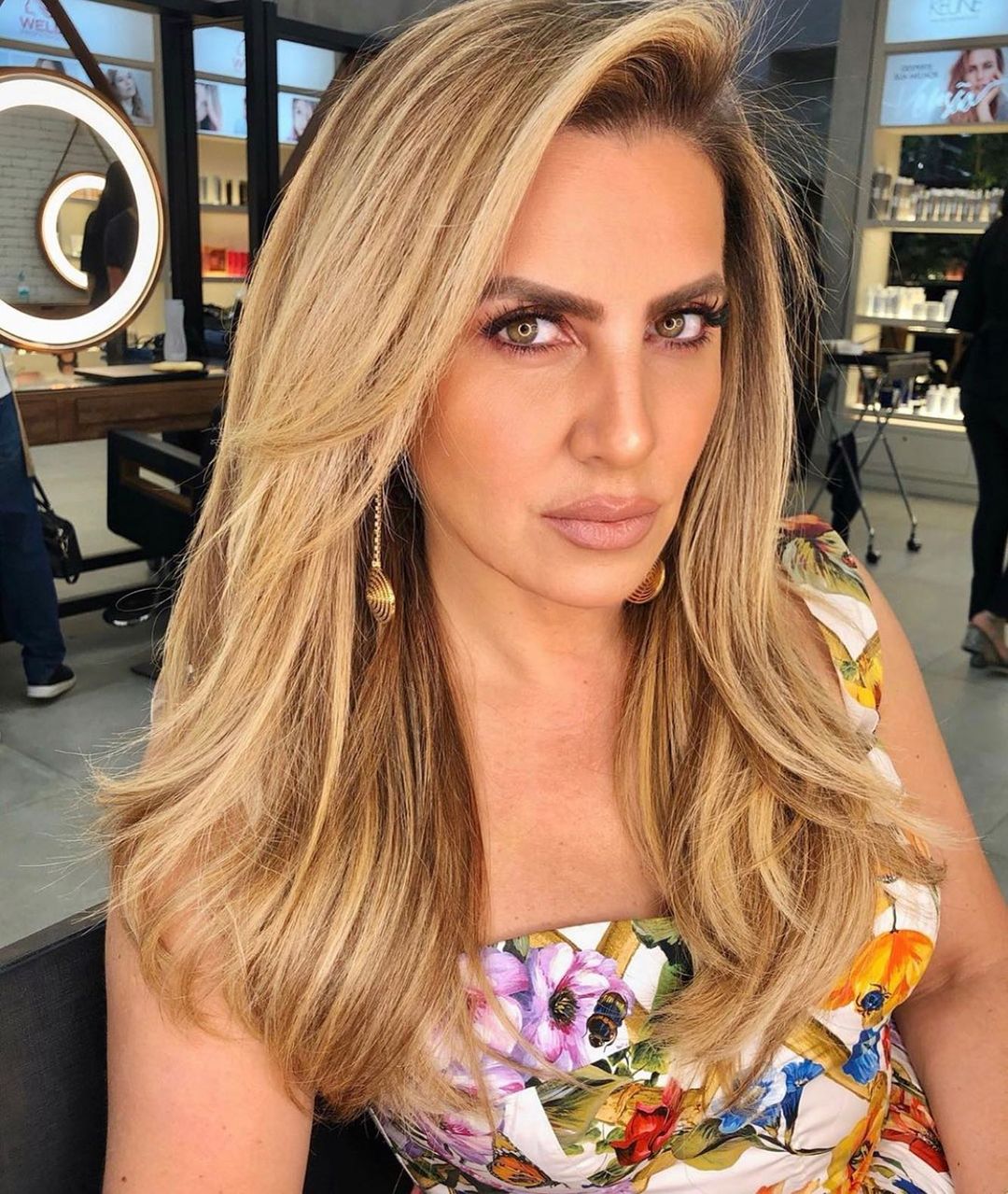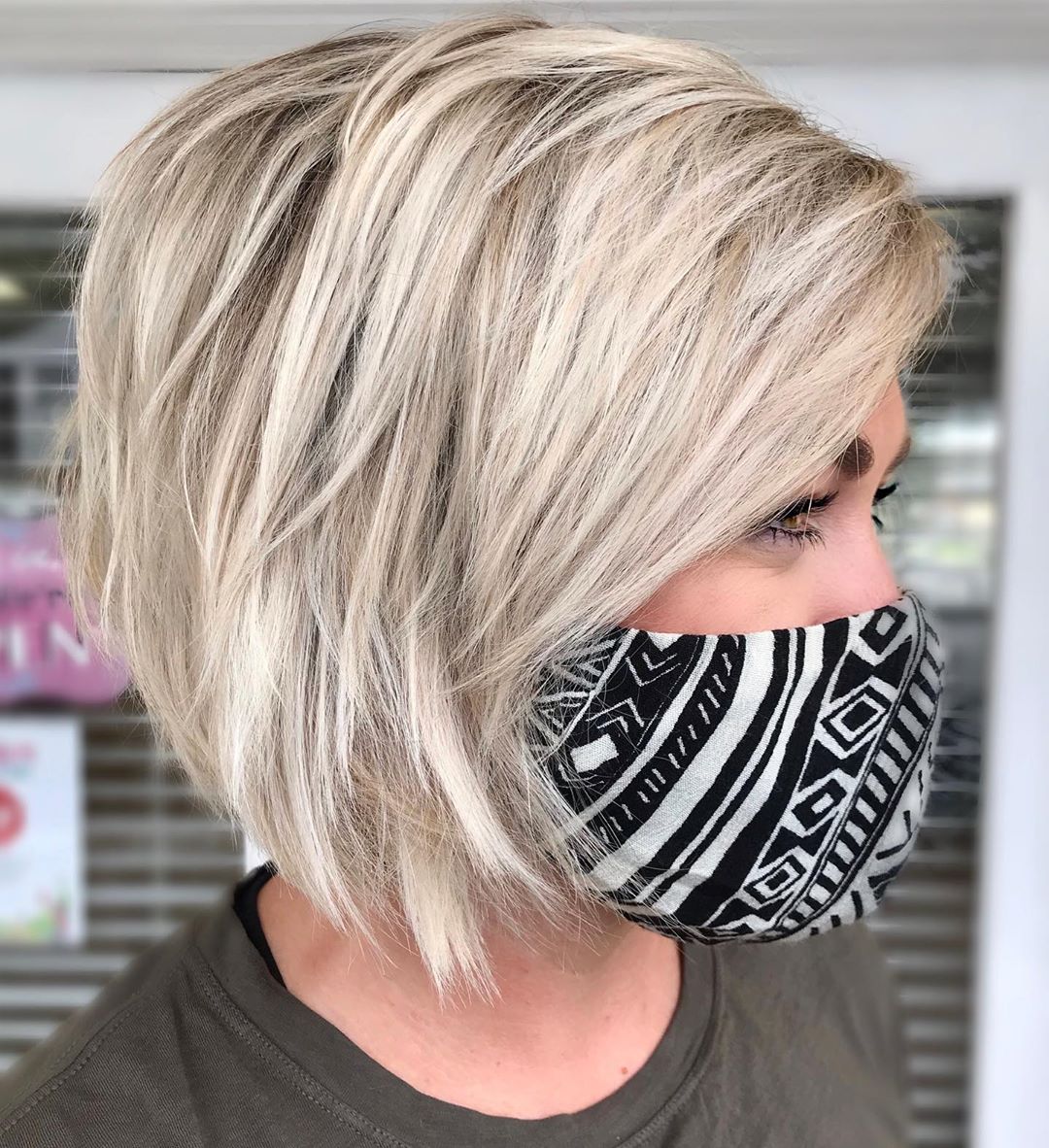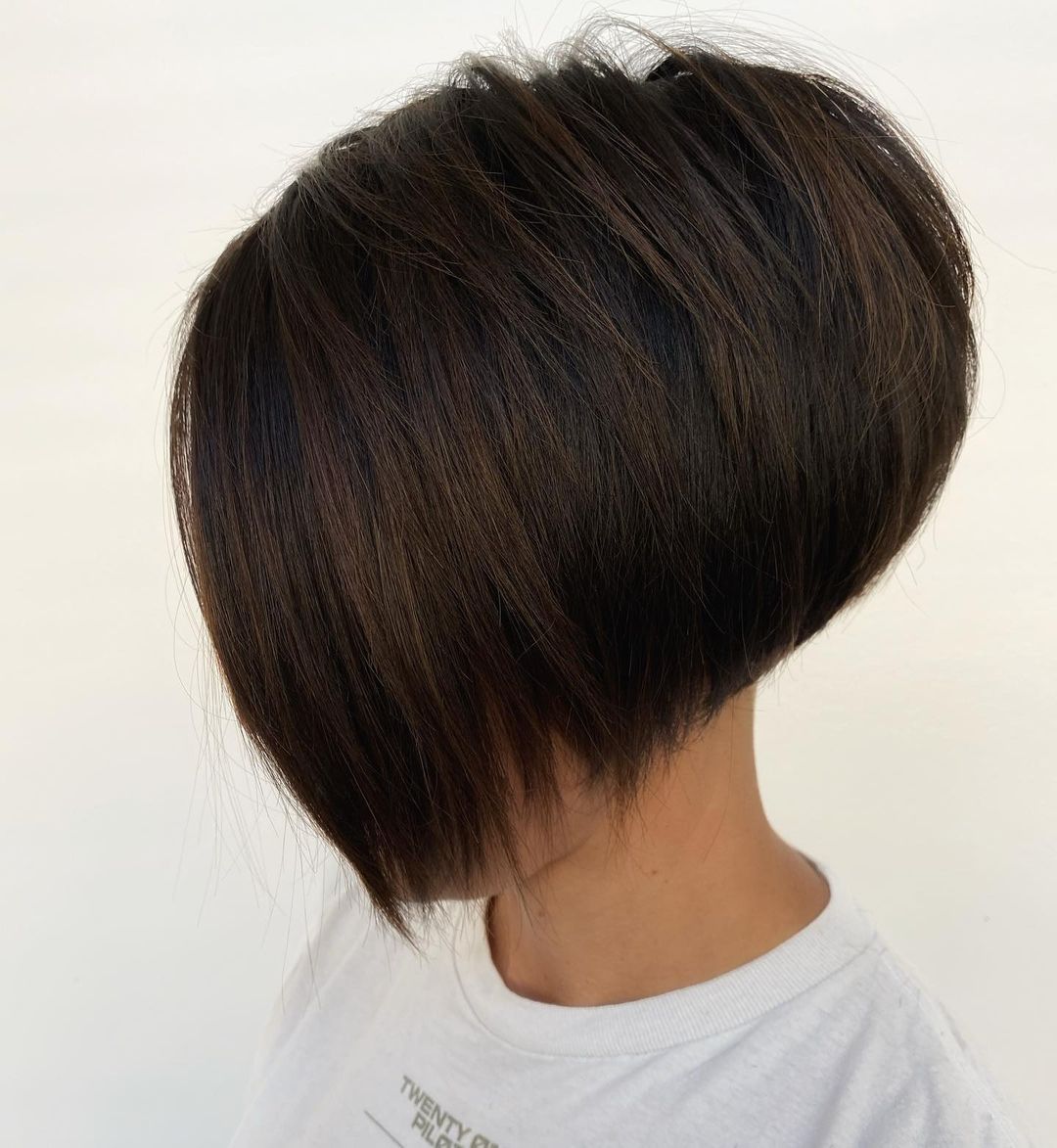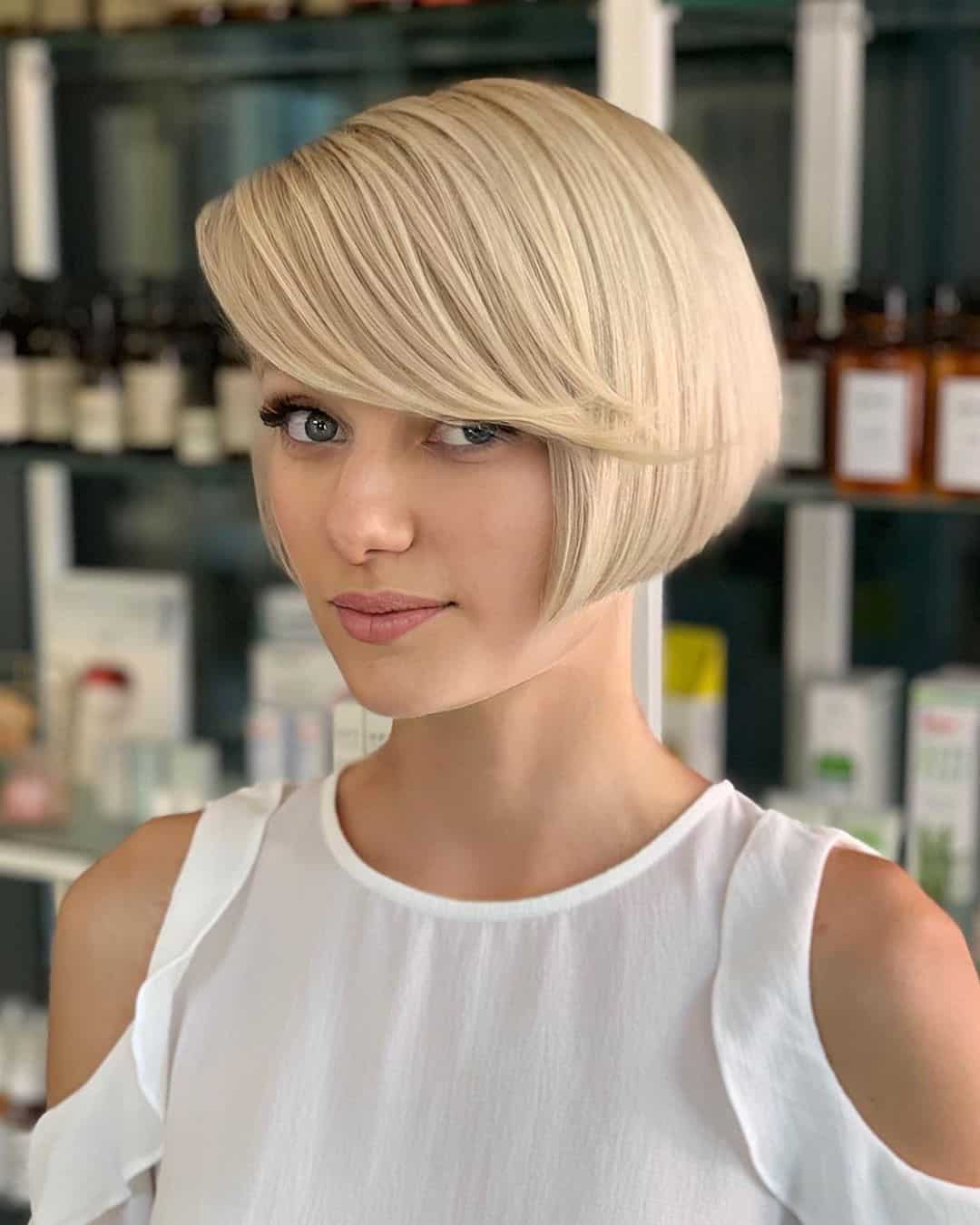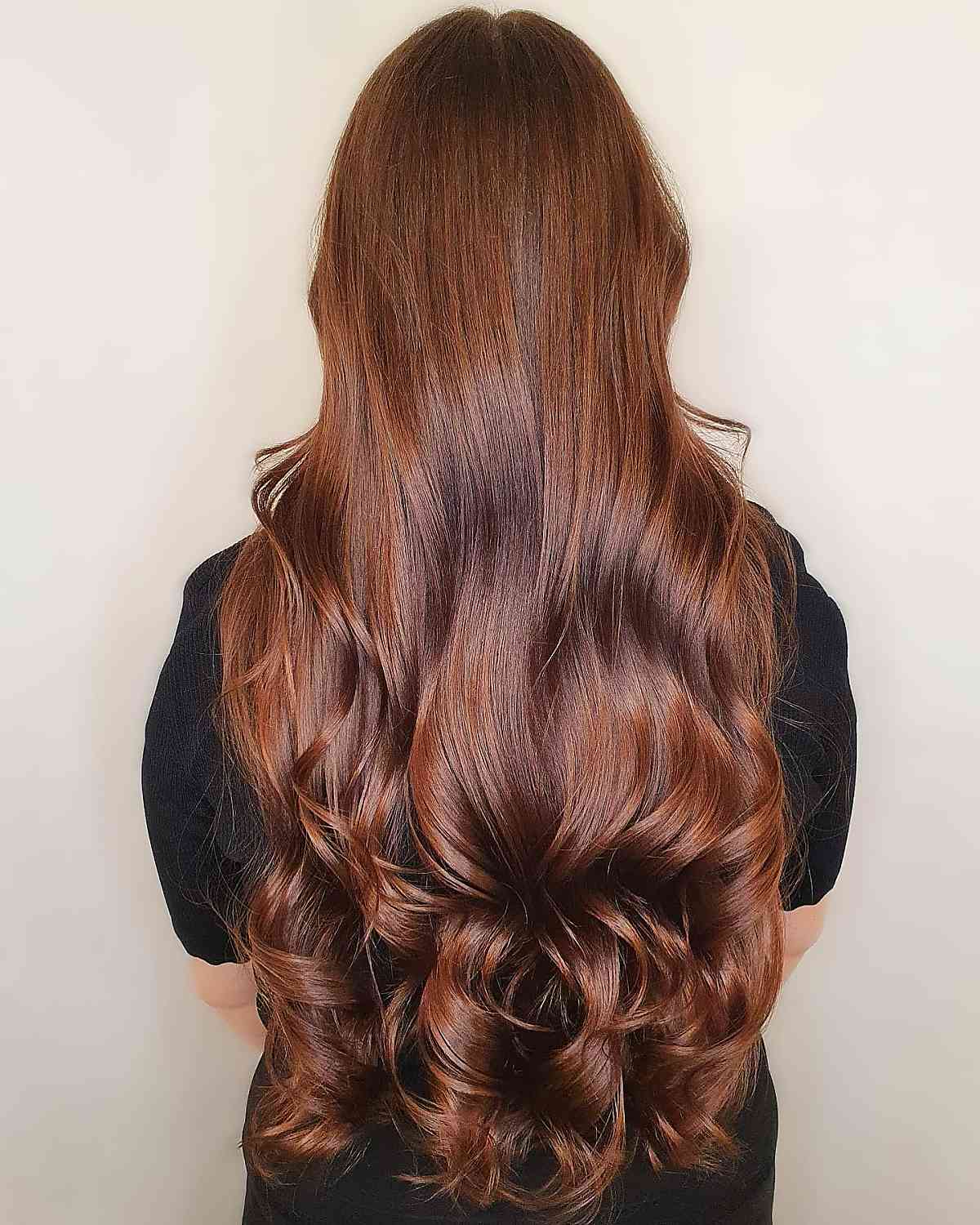In recent years, the word “thick” has taken on a whole new meaning! But if you’re a woman with thick hair, you might not see this word as a compliment.
As a hairdresser, I’m very familiar with the trials and tribulations of having too much hair. With this hair type, you deal with some very frustrating issues in the salon and while styling at home.
That’s why I compiled this guide and gallery on the ideal haircuts for women with thick hair! When you’re done reading, you’ll have no problems choosing a fabulous hairstyle during every salon appointment.
What is Thick Hair?
Thick hair is characterized by a high density of individual hairs per square inch. (Source) Studies have found the average human hair density is between 800 – 1,290 hairs per square inch. (Source)
That said, it’s not exactly easy to measure this! If you’ve ever been told you have thick hair while getting your hair done, that’s a clear indicator. You can also look in a mirror. You probably have thick hair if you can’t see your scalp at all while your hair is down.
And having thick hair comes with its trials and tribulations. For example, finding a cut that removes enough bulk but is still long enough to ponytail can be tricky. Long shags are among the most versatile haircuts for women with thick hair.
But you can wear them short, too! Bob haircuts are an excellent option for making thick hair feel lighter.
Honestly, any length can suit thick hair so long as the cut is tailored to suit you. Even medium-length hairstyles can reduce bulk and add movement!
Thick Hair vs. Coarse Hair
Thick hair and coarse hair aren’t the same thing. You see, it refers to the density of hairs across your scalp.
But coarse, medium, and fine hair relate to each hair strand’s diameter. You might have thick, coarse hair, thick, medium hair, or even thick, fine hair.
Here’s how to determine if you have thick or coarse hair:
Pinch one strand of hair between your thumb and forefinger, and slide your fingers down. Be gentle– you aren’t trying to pull this hair out, just feel it.
If the strand feels like sliding your fingers down sewing thread, you most likely have coarse hair.
You probably have fine hair if you can’t feel the strand (or barely can). And if it falls somewhere between these two ends of the spectrum, your strands have a medium diameter.
The Best Haircut for Your Face Shape
Your biggest goal is most likely getting your thick hair to feel light and manageable. But it would be best if you never got a haircut without considering your face shape. If their facial shapes differ, the same style looks completely different on two women with thick hair.
So, I’ve compiled some tips for each face shape below. But keep in mind that we’re all unique individuals! If you feel that you don’t 100% fall into a specific category, that’s okay. Try to marry my tips from the two face shapes closest to yours.
- Diamond. You’ll want a haircut that makes your cheekbones look a bit less wide. If you like edgy cuts, a chin-length mullet would be perfect. A textured bob with lots of facial framing would suit you well for something timeless. Long hair is fine, too—facial framing is the key element.
- Heart-Shaped. The goal of a heart-shaped face is to make your forehead look narrower. Avoid styles with lots of volume in the top and crown. A shoulder-length lob would look great. If you have curls, a medium shag will create the perfect balance.
- Oval. This is the ideal face shape, so you aren’t trying to create any specific illusion. Any haircut that lightens your thick hair and suits your lifestyle will be a great fit.
- Round. You always want to make a round face look longer. Long hair is the best way to do so. At the same time, you still need layers to reduce bulk. Try a shoulder-length cut with facial framing and textured layers for the best of both worlds.
- Square. The ultimate goal here is softening and rounding the hard angles of your face. So, blunt lines are a no-go. Any length can create softness as long as you have a lot of texture, even through your ends. No matter what cut you choose, ask for facial framing starting around your cheekbones and point-cutting throughout.
- Rectangle. A common challenge with this face shape is sunken or hollow-looking cheeks. The best way to counteract this is with a chin-length layered bob or shag. I suggest asking for layers that create volume around your cheekbones, too. This combo creates the illusion of an oval face shape.
Do Bangs Work with Thick Hair?
Bangs can be an excellent choice for women with thick hair. Fringe is one more way to add lightness and reduce bulk.
But just like choosing a haircut, you should keep your face shape in mind. Bangs of the wrong length or style can draw attention to all your least favorite features.
So, here are my recommendations for bangs for each face shape:
- Diamond. Most types of bangs are a great way to make a diamond face look more oval-shaped. A longer side-swept fringe is one of the best options. So are curtain bangs and bottleneck bangs. But avoid blunt fringe—that’ll make your cheeks look even wider.
- Heart-Shaped. Bangs to avoid are a blunt, straight bang, and micro-fringe. Both will make your forehead look much larger. Instead, try swoopy bangs or layered side bangs. The shortest point should be at your eyebrow, and the longest should be at the top of your cheekbone.
- Oval. Because you have the ideal face shape, you can wear any bangs you like. Consider your hair texture and desired level of upkeep to make the best choice. You’re also free to skip bangs altogether.
- Round. Since the goal is elongating your face, you must be cautious with bangs. A full, blunt fringe will create the undesirable “moon face” effect. Long curtain bangs or textured side bangs would be good choices. You can also opt for no bangs at all.
- Square. Remember, the goal is to add softness and curves. You’ll want texture and layers no matter which type of fringe you get. You can get away with a full, textured fringe. But a better option would be eyebrow-length swoopy bangs or curtain bangs with facial framing.
- Rectangle. Bangs are a perfect match for a rectangular face shape. Bangs tend to shorten your face, which is exactly what you want. You have to be mindful of the length. A long fringe will make your face look even longer, as will baby bangs or micro-fringe. Try full, blunt bangs at eyebrow length or textured side-swept bangs that graze your cheekbone.
Pro Tips on Hair Lengths for Women with Thick Hair
Every length of hair can be customized in lots of ways. This is especially true when you have thick hair. You have more hair to work with than someone with medium or thin density!
But each length can present certain advantages and challenges, too. Next, I’ll go over my tips for each length.
Very Short Hair
“Very short” haircuts are either clean around your ear or barely cover your ears. Pixies, lixies, and ultra-short bobs are good examples.
If you’re a thick-haired, curly girl, this length can be fun. You can show off your personality by styling the top without fussing over controlling the sides.
This length is excellent for thick-haired women of any hair type, though. Having so much hair gives you tons of personalization options. You can get punky with designs shaved in the sides or even shave a side shorter than the rest.
You can try a bob that skims your cheekbones or a pixie with a swoopy bang for something more polished. Styling takes little time since you don’t do much with the sides besides wetting them down and combing.
The one thing to consider is salon maintenance. Precision haircuts on thick hair tend to lose shape and sharpness faster than thin hair.
If you’d instead visit the salon as rarely as possible, a short or medium haircut is a better option.
Short Hair
“Short” haircuts are about chin-length or a bit longer. Most bobs fall into this category, as do short mullets and shags.
Shorter cuts can make life a lot simpler if you have thick hair. Your ends will be too short to pull back with a scrunchie. So, you can go crazy with layers and texture– this will lighten your hair quite a bit. And unlike medium or long hairstyles, you aren’t aiming for lengths that can be pulled back.
You can still get creative with clips and small braids at this length. Getting the fringe or the sides off your face is possible.
If you have curly hair, this length can create more volume instead of reducing it. But you can still ask for lots of layering and texture to reduce the actual weight of your hair.
This length could be better for thick-haired, curly girls who want their hair to lay flatter. If this describes you, choose a medium or long hairstyle.
Medium-Length Hair
“Medium” hairstyles are any that skim your shoulders or hit at your collarbone. Lobs, medium shags, and layered cuts can be this length.
Depending on your lifestyle, this length can be great for thick hair. The ends are usually long enough to pull back, but you need help dealing with the weight of long hair.
But remember that lobs and shags can be tough to put in a ponytail or bun. The various layers and shaping mean some pieces might fall out of your scrunchie. The same is true for any braids you might do.
Long Hair
“Long” hair is any style that hits around your shoulder blades or longer.
Long hairstyles can be good or bad for women with thick hair. It’s always nice to pull everything into a ponytail and get it off your face.
If you want to rock long locks, facial framing, and layers will help lighten your hair and reduce bulk. But think about if you need to be able to pull every hair back. I prefer having a few piece-y bits of framing my face. But I’m also not working in environments where I need my hair 100% up!
Think about your lifestyle and needs. And don’t be afraid to explain them to your hairdresser! When we know what you need from a haircut, we can customize it.
Hair Type Considerations
So far, I’ve mostly talked about hair density. But we can only discuss haircuts for women with thick hair if we also cover hair types. You see, it’s possible to have thick, wavy hair, thick, straight hair, and many other varieties.
To pick the best hairstyle for you, think about your face shape and your hair type, too. Here are my suggestions for each:
- Wavy. Thick hair and a wavy texture make a great match. Shorter layers will make your hair feel lighter and show off your waves. A mullet with choppy layers would be a fun, trendy choice. For something more classic, try shoulder-length ends with framing and short layers.
- Curly (including perms). This pairing can be a little trickier. If your layers stay longer, your hair can look too thick and uncontrolled. Stacked inverted bobs are the best choice for you in terms of appearance and maintenance. But a medium or long shag with blended layers would be flattering too.
- Coily. Thick, coily hair is most prone to that awful “pyramid” grow-out. Try a classic bob with many layers for a fresh, youthful option. Try a shoulder-skimming style with short layers and curly bangs for something sleeker.
- Straight (including relaxed hair). Straight, thick hair can be tricky. The wrong type of layers will make your hair look choppy and uneven. You should avoid choppy layers altogether. A lob with blended layers would be breathtaking. If you want a trendier cut, a pixie cut or angled bob would be easy to style daily.
- Gray. If your grays are wiry and unruly, the easiest thing to do is embrace them! A pixie cut or short shag would work well. Plus, both styles will lighten your thick hair. A stacked bob will reduce thickness and add movement for those almost-too-soft white hairs.
- Damaged or heavily processed. You’re lucky because the same options benefit thick and damaged hair. The shorter your layers and ends, the better. You can go for any pixie cut or layered bob. Do you want longer locks? Just ask for point-cutting in your ends and lots of blended layers. Bangs and facial framing will help cut down on split ends, too.
How to Style Haircuts for Thick Hair
With thick hair, daily styling can be exhausting—literally. Keeping your arms up for ages while blow-drying, curling, or flat ironing can be tiresome.
Check out my tips below to reduce your time in front of the mirror each day.
Styling Damaged or Heavily Processed Hair
Styling is hard enough when you have thick hair. But when your hair is damaged, it’ll take longer to dry, curl, or straighten your locks. This causes even more damage since your hair is heated for even longer. It’s a vicious cycle.
But the right product can change everything. And that product is Paul Mitchell Awapuhi Wild Ginger Styling Treatment Oil. It’s been my secret weapon for processed, thick-haired clients for over a decade.
This oil is very lightweight yet ultra-nourishing. That means it’ll reduce drying time and add weightless, non-greasy shine. You can apply a pump or two to your damp mid-shafts and ends. Or use a single pump on dry hair to add shine and gloss. Either way, your styling routine is about to get much simpler.
If you apply it to damp hair, I suggest waiting about 5 minutes before turning on your blow-dryer. This gives the treatment time to penetrate and absorb into every strand fully. Then, you’re free to style however you like. You can expect your hair to feel softer, silkier, and less coarse/thick.
Styling Wavy, Curly, or Coily Hair
Many clients have shared their woes over having thick, curly hair. And I get it. Curls, waves, and coils take special care and attention. But having thick hair means you already spend a lot of time styling. The last thing you want is a texture that adds more time to your morning routine!
But don’t worry—I’ve got a product recommendation to simplify all that nonsense. And you can use it whether you want to enhance your curls or straighten them out for the day.
If you have wavy or curly hair, It’s a 10 Miracle Leave-in Product is my suggestion. Every product from this brand benefits your hair in 10 distinct ways. This one, for example, is a heat protectant, detangler, and frizz fighter.
Mist this over your damp hair, focusing on your mid-shafts and ends. You can do a light mist on your roots. Then, you’re free to scrunch or blow-dry as desired.
If you have a coily texture, opt for It’s a 10 Coily Miracle Leave-in Product. It’s formulated to make braids, wear your hair down, or straighten quickly and easily. Like the version for waves and curls, mist this over your damp hair. Using a bit less on your roots will preserve your natural volume. Then style any way you like!
How Women with Thick Hair Can Reduce Volume and Bulk
I’ve taught you all about how to style your hair faster and give your arms a break. Now, we can dive into how to style and reduce natural volume/bulk.
I have a blow-drying technique I’ve sworn by for over a decade. And, of course, I have a few products in my arsenal to suggest, too.
When you blow-dry, you’re going to do what’s called a “flat wrap.” This method reduces the most volume, no matter your hair type.
Split your damp hair into four sections. Make the hair in front of your shoulders on each side into sections. Then, draw a vertical line from your crown to your nape for the last 2.
Clip 3 sections out of the way so you can dry one at a time. You’ll also need a paddle brush (not a round brush).
As you dry, brush the hair in one section forward, towards your face. Picture your brush drawing a diagonal line that slants down towards your shoulders. It’s important to keep your roots directed down and forward, not up– that would add volume.
Try to follow your brush with your blow-dryer so the air current follows that same diagonal line. Drying your hair by keeping it flat and “wrapping” it around the curve of your head will reduce volume.
If your blow-dryer has a “cool” setting, use it to cool down each section as you finish. This locks in the reduced volume and keeps your hair from poofing throughout the day.
Best Products for Sleek, Smooth Hair
Aveda Smooth Infusion Glossing Straightener has been one of my favorites for years. It adds all-day straightness, shine, and poof control. It also provides 12 hours of humidity defense to any blowout. It’s perfect for getting that sleek, straight, glossy finish you normally associate with a salon appointment.
Work a small amount in both of your hands. Then apply to damp, towel-dried hair and brush through. Follow with the blow-drying technique above, and you should need minimal touch-ups with your flat iron.
If you aren’t trying to remove your curls, I recommend the Smooth Infusion line. You’ll want Aveda Smooth Infusion Style-Prep Smoother. All products in this line cut down on drying time, but this one won’t relax your curls or waves. It’s perfect for controlling frizz and poofiness without weighing you down.
Use two pumps for short or very short hairstyles. You can go up to 5 pumps for long hair. Emulsify it in your hands and apply it to damp hair from roots to ends. You can then blow-dry or air-dry as desired. Either way, your hair should look smoother and sleeker.
Maintaining Your Hairstyle
All haircuts require some level of maintenance. I’m talking about salon visits to keep your hair feeling light and daily styling to look how you want. Have you ever walked out of the salon feeling great but frustrated by the upkeep? It’s the worst!
That’s why I’m also sharing my tips on maintaining haircuts for women with thick hair. No matter your lifestyle or routine, I’ve got ways to simplify the upkeep.
Haircut frequency:
- You want to visit the salon as rarely as possible. The more layers and texture you get, the longer your cut will last longer. A medium or long shag with short layers would be ideal. Any razor cut will give you longevity, too.
- You like getting a haircut every 8 to 10 weeks. Depending on your hair type, a pixie might be workable. Curlier textures would need more frequent trims with this haircut, though. A layered bob, lob, or long layered cut would be more suitable for curls.
- You’ll make appointments as often as you need to maintain a style. Do whatever you want! With thick hair, you can get specialty details like a design shaved into the sides or nape. These customizations are super eye-catching with your hair type. They need frequent touch-ups. Micro-fringe and asymmetrical cuts are fun choices, too.
Daily styling:
- You don’t have much (if any) time to style each morning. The key is picking a cut that suits your natural texture. This means angled bobs and any amount shoulder-length or longer on straighter hair. You’ll want a layered bob or curly shag for curly textures so you can scrunch and go.
- You have 15 or so minutes to spare for daily styling. Since you have thick hair, you’ll still want something that suits your texture. Curling your hair, for example, takes far longer on thick hair than on thin hair. But it would be best to experiment with bangs, layers, and facial framing. These options can be styled quickly, regardless of hair density.
- If it takes you an hour to do your hair, you don’t mind. Pick any style from the gallery that you like! But be aware of what you’re signing up for. If you have curly or wavy hair and show your stylist a cut that flatters straight hair, wearing your hair natural will be hard. Asking for lots of layers, texture, and thinning will help reduce styling time for any haircut.
The Best Haircuts for Women with Thick Hair
Now you’re ready to find your next haircut! Even better, you know to pick something that’ll 100% suit your face shape, hair type, and lifestyle. Check out the gallery below for some of my favorite options.
